This document is a comprehensive introduction to Object-Oriented Programming (OOP) using Java, detailing its features, syntax, and key concepts such as classes, objects, encapsulation, inheritance, and polymorphism. It covers Java naming conventions, the creation of classes and objects, data types, operators, control statements, loops, and arrays, providing examples and explanations. Additionally, it discusses Java's compilation and execution processes, emphasizing the benefits of OOP and Java's robustness as a programming language.
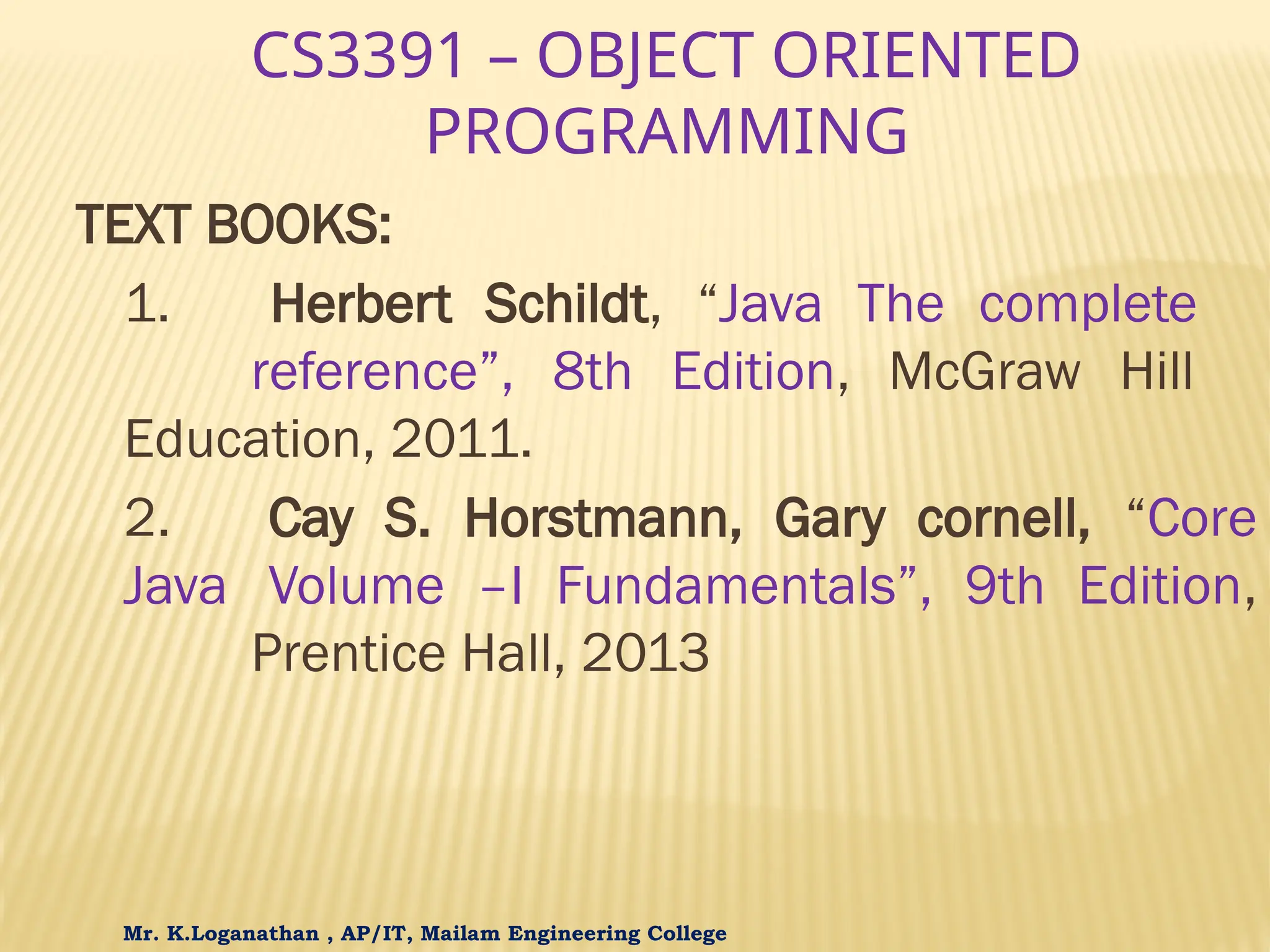
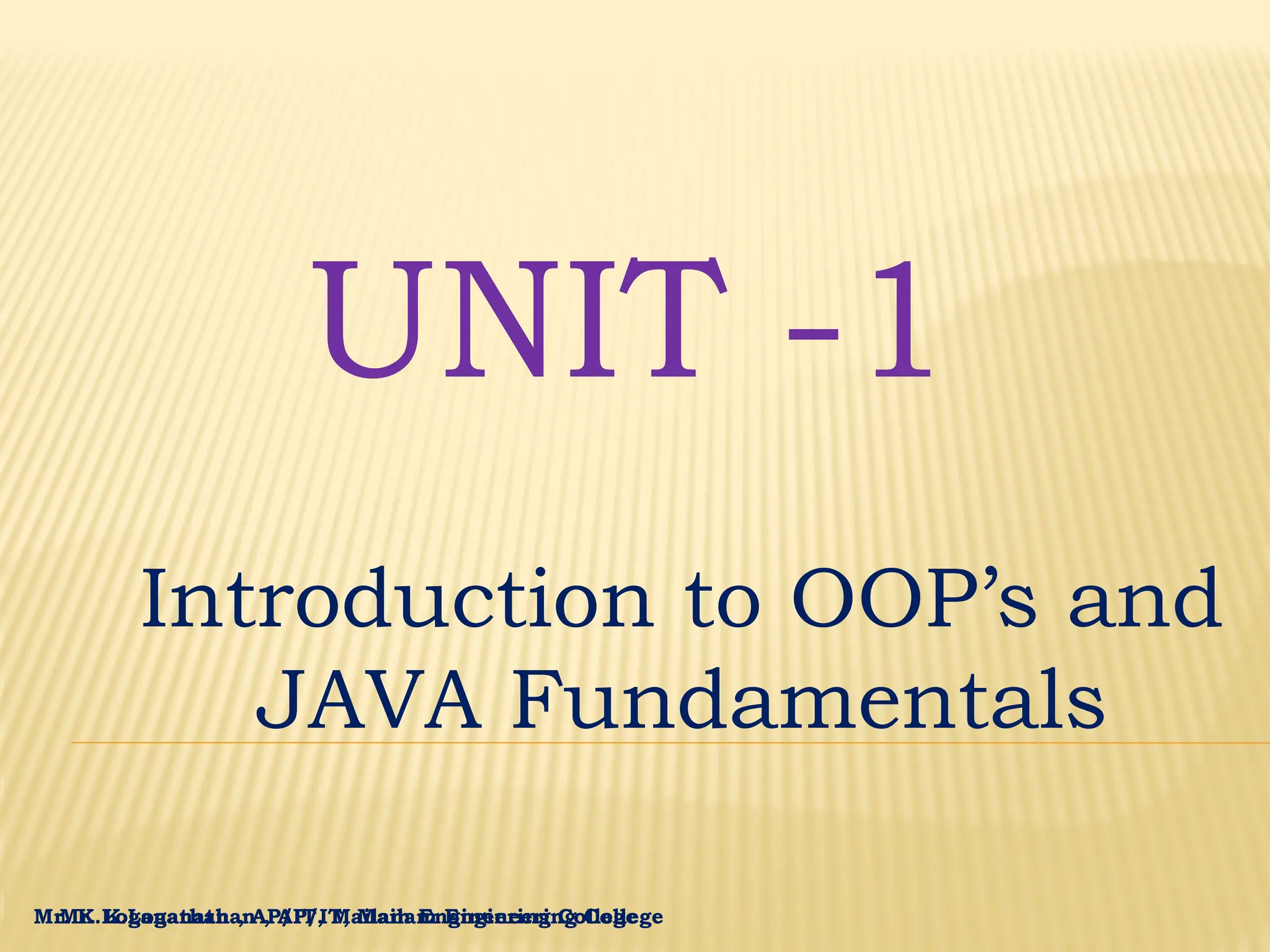

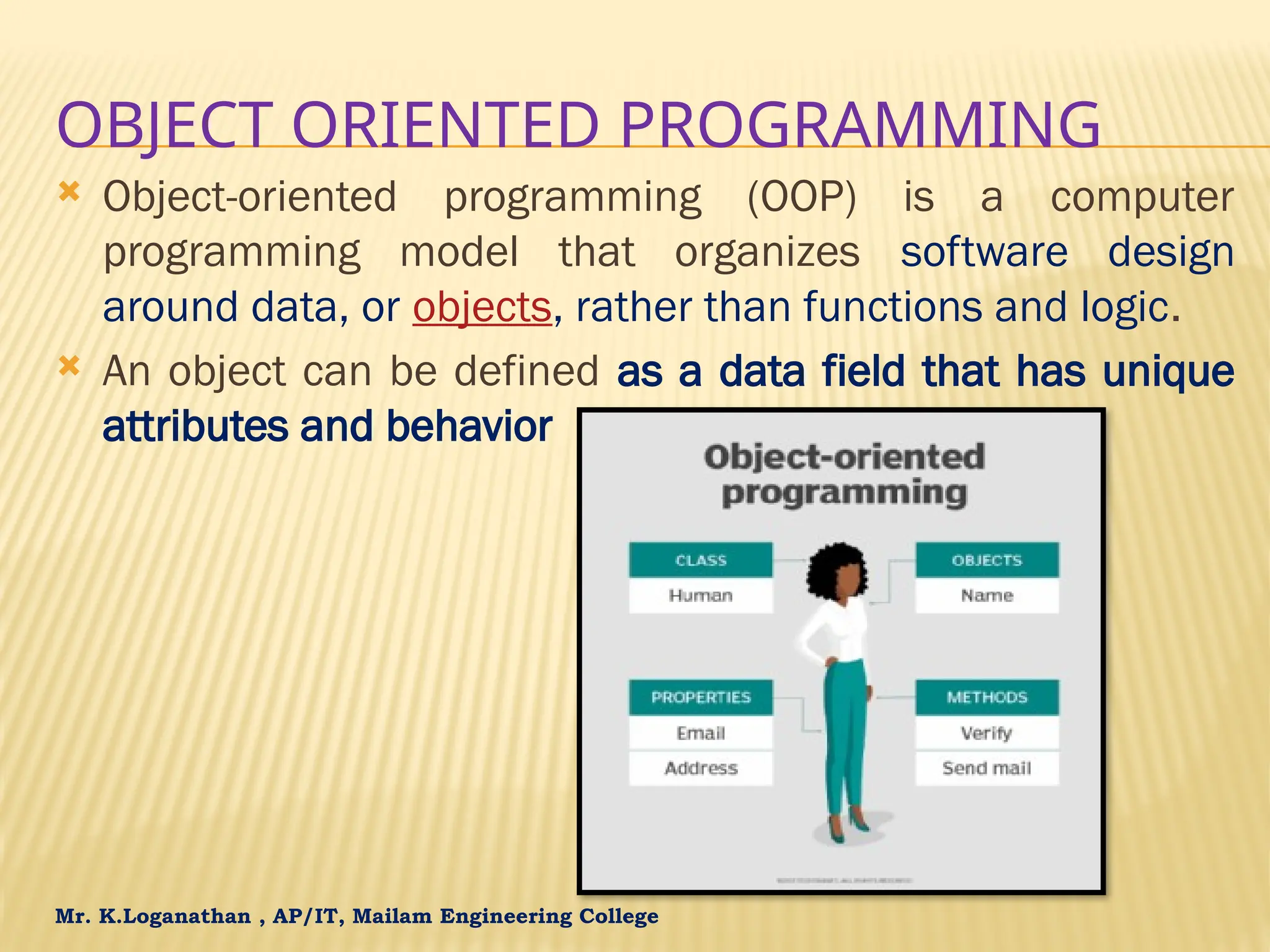
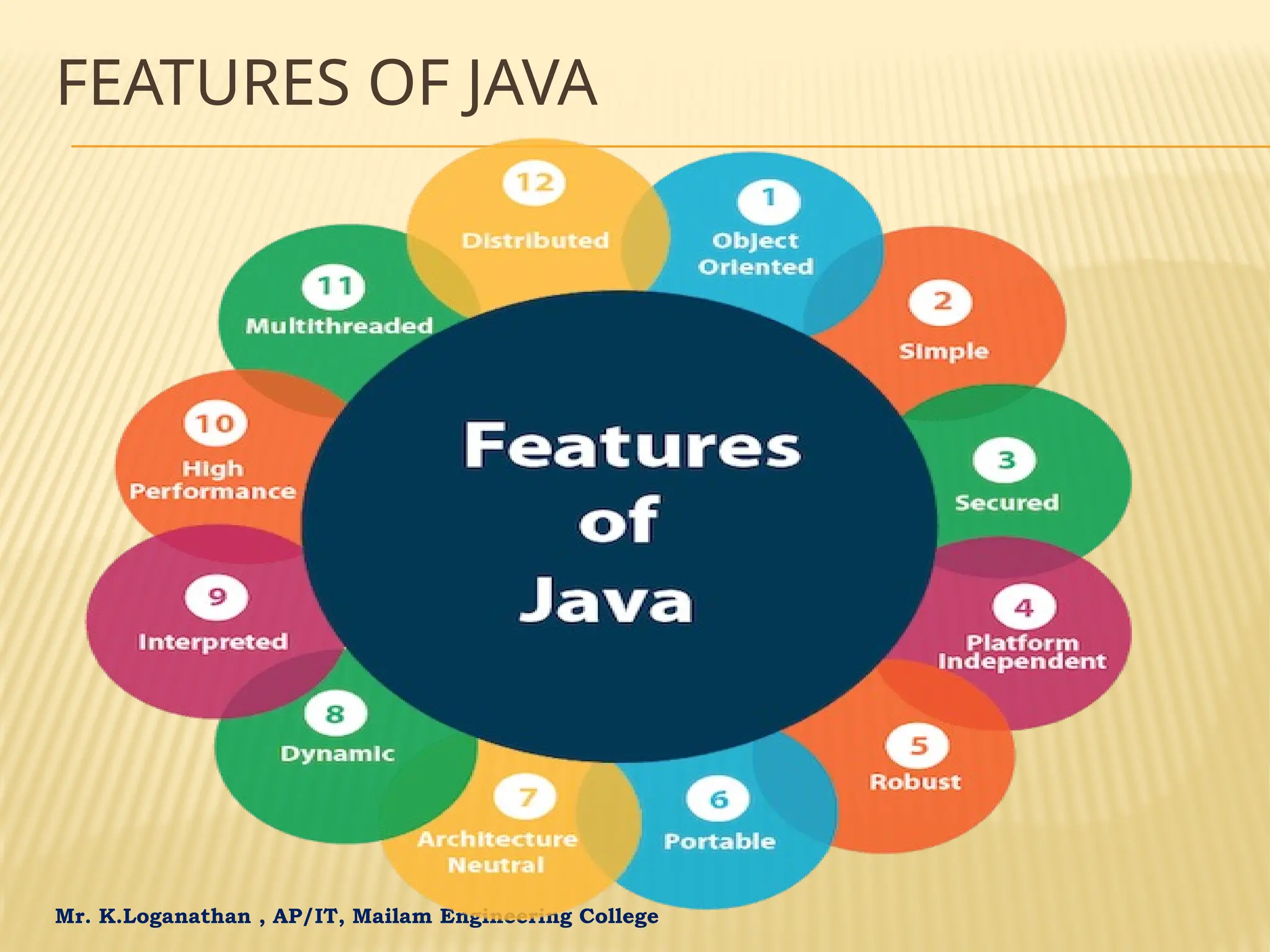

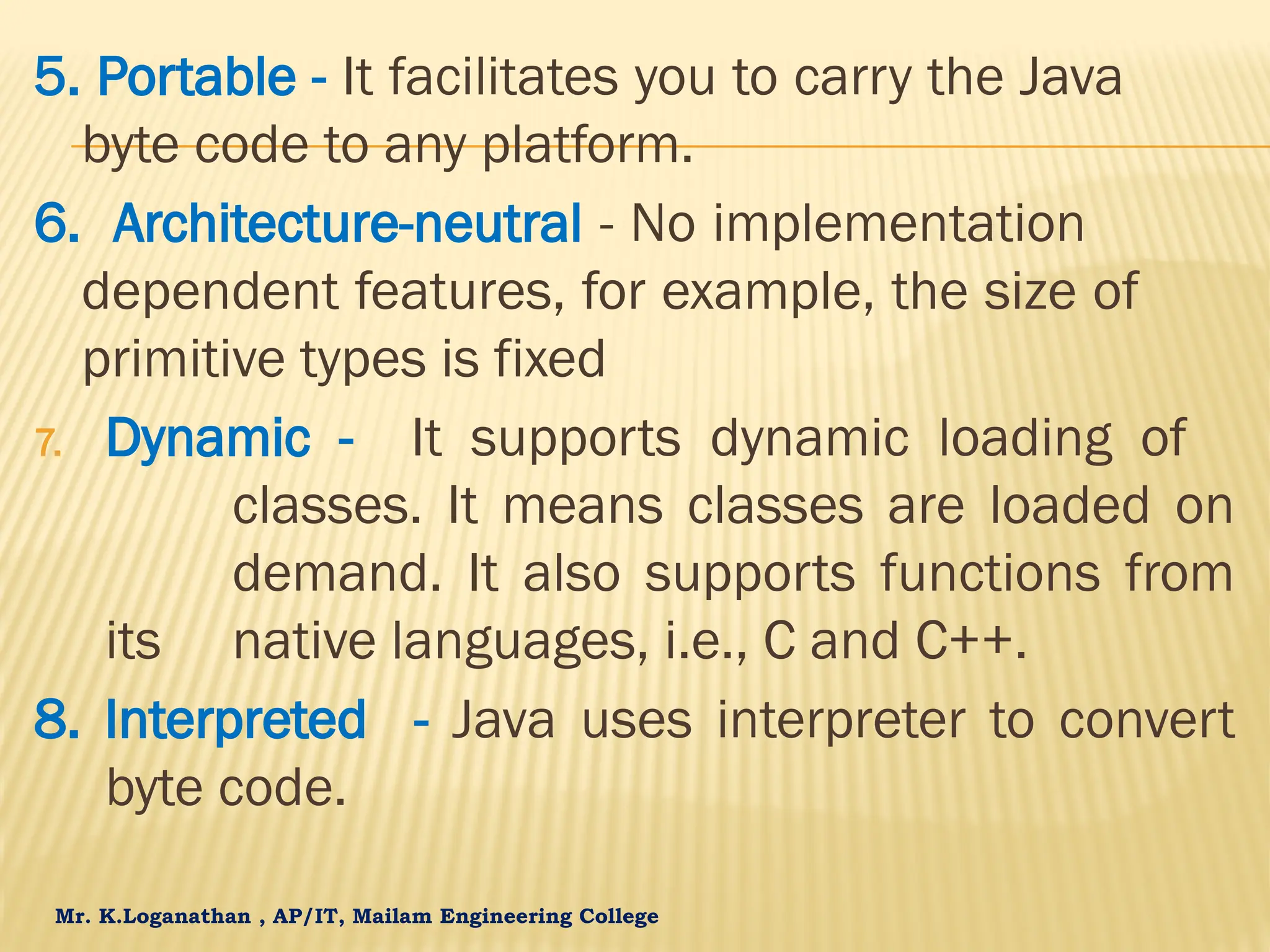
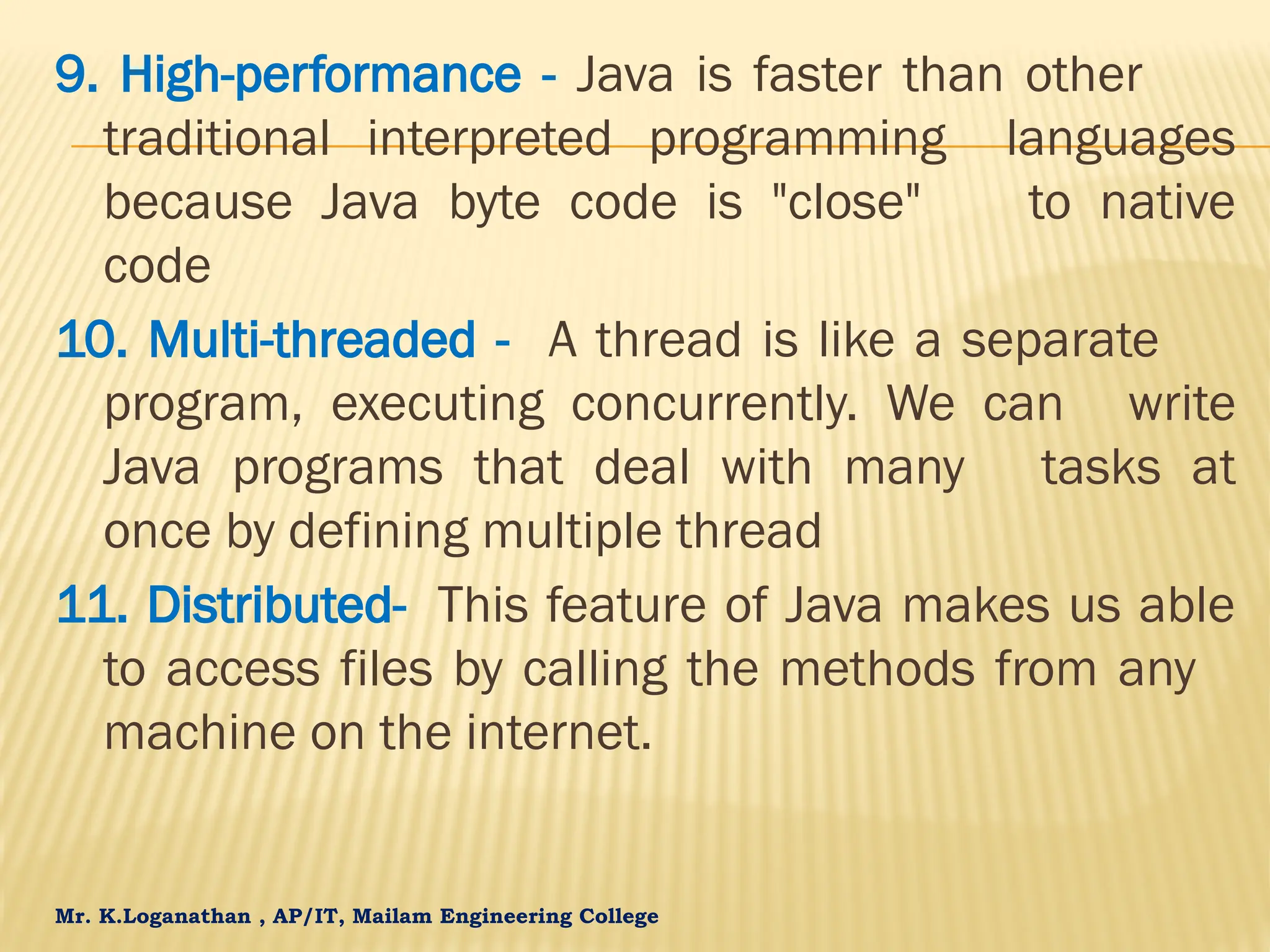

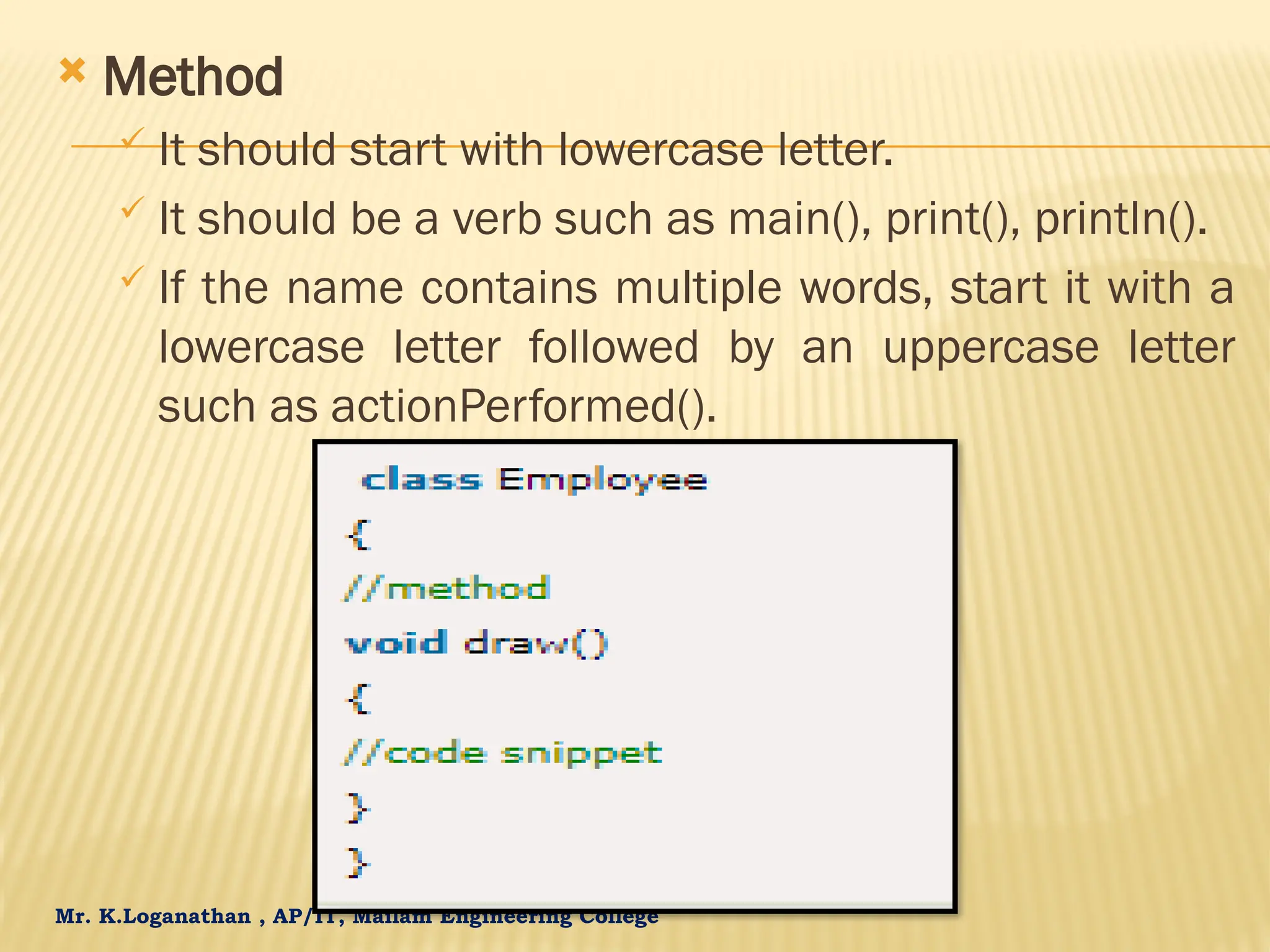
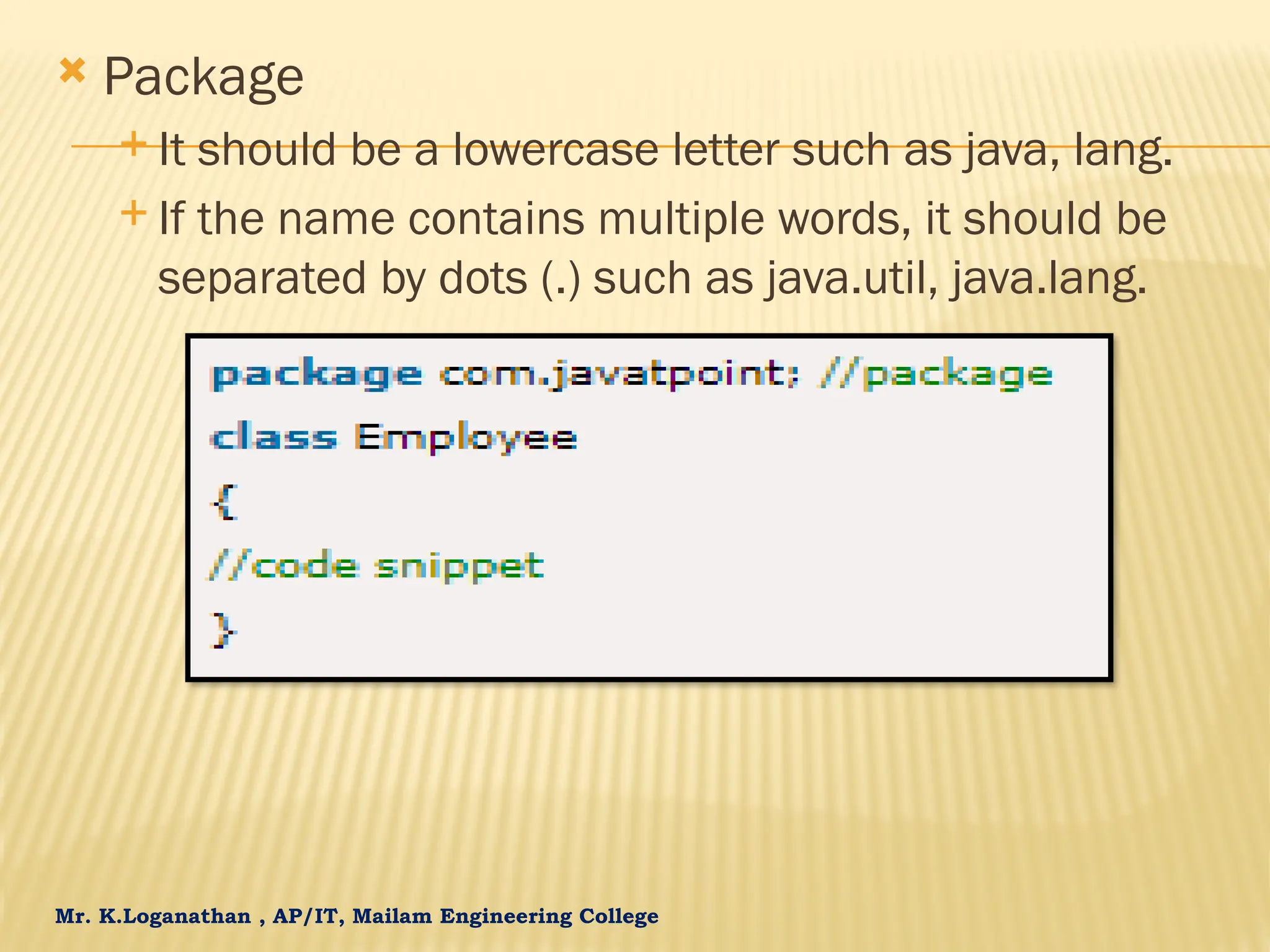

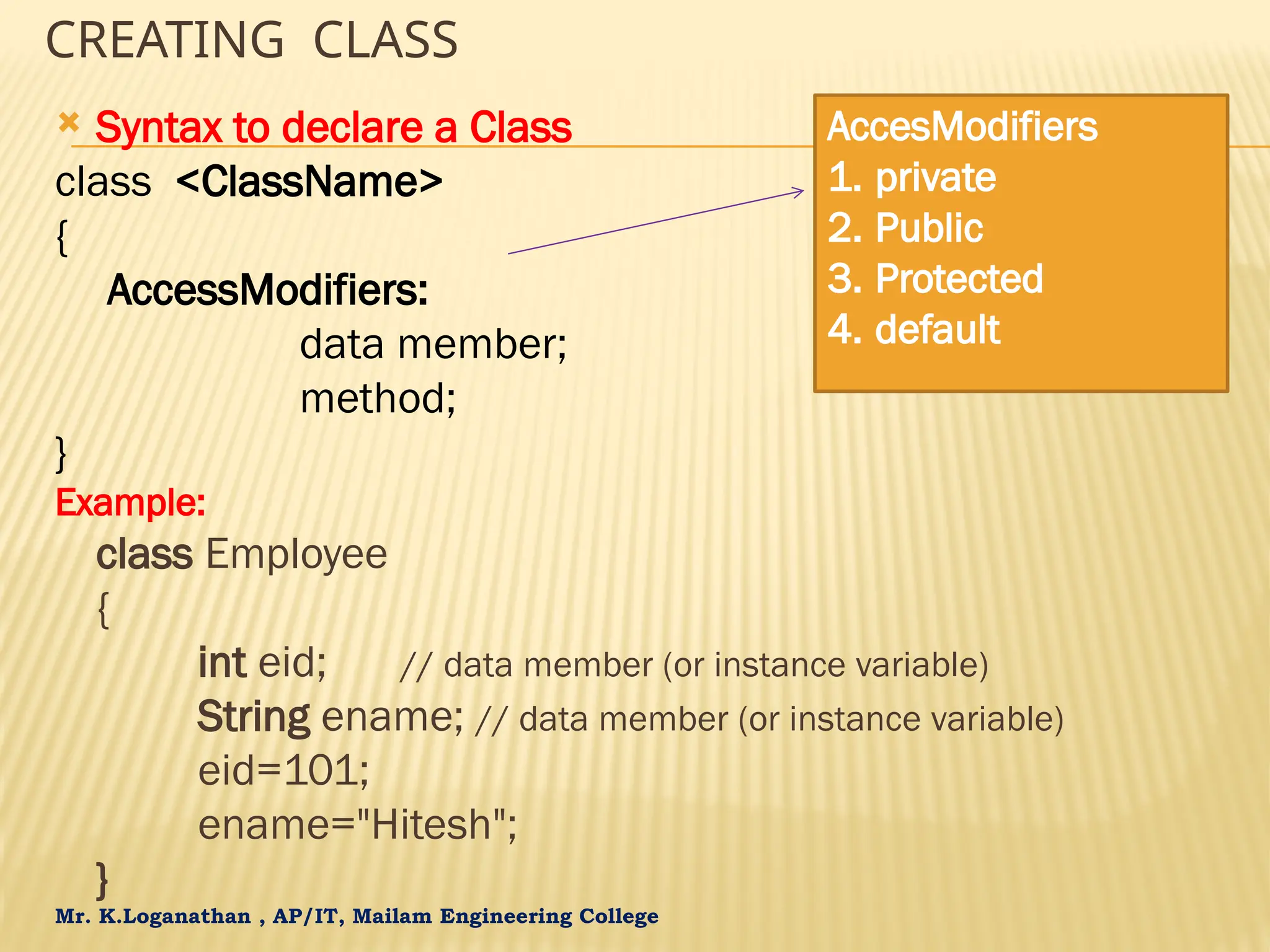

![Mr. K.Loganathan , AP/IT, Mailam Engineering College FIRST JAVA PROGRAM class Simple { public static void main(String args[]) { System.out.println("Hello Java"); } } Output: Hello Java](https://image.slidesharecdn.com/oopsunit-12-240820005458-4d788f30/75/CS3391-Object-Oriented-Programming-AU-Reg-2021-15-2048.jpg)
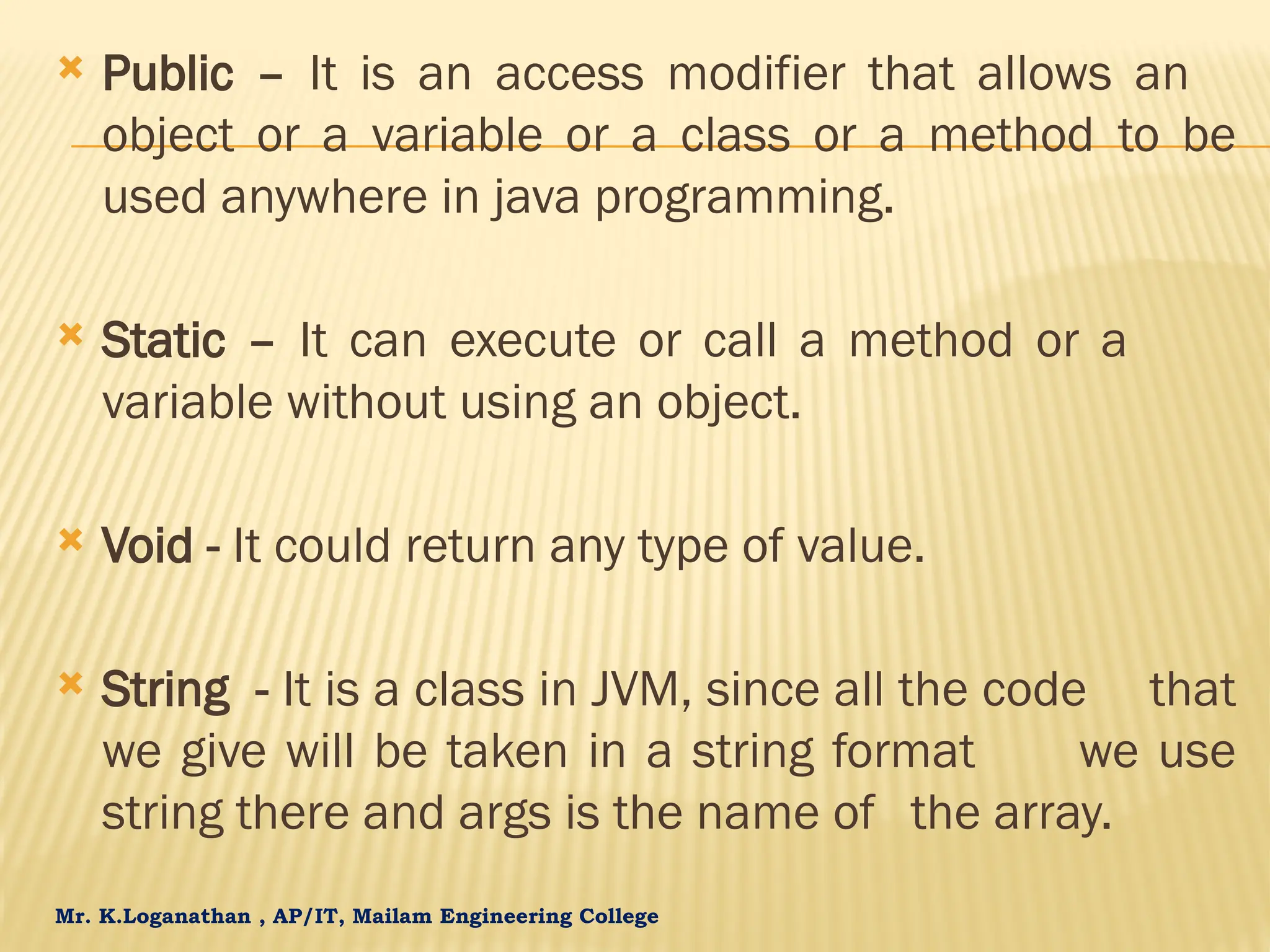


![Mr. K.Loganathan , AP/IT, Mailam Engineering College PRIVATE: Private members of class in not accessible anywhere in program these are only accessible within the class. class Hello { private int a=20; private void show() { System.out.println("Hello java"); } } public class Demo { public static void main(String args[]) { Hello obj=new Hello(); System.out.println(obj.a); //Compile Time Error, you can't access private data obj.show(); //Compile Time Error, you can't access private methods } }](https://image.slidesharecdn.com/oopsunit-12-240820005458-4d788f30/75/CS3391-Object-Oriented-Programming-AU-Reg-2021-19-2048.jpg)
![Mr. K.Loganathan , AP/IT, Mailam Engineering College PUBLIC: Public members of any class are accessible anywhere in the program in the same class and outside of class, within the same package and outside of the package. class Hello { public int a=20; public void show() { System.out.println("Hello java"); } } public class Demo { public static void main(String args[]) { Hello obj=new Hello(); System.out.println(obj.a); obj.show(); } }](https://image.slidesharecdn.com/oopsunit-12-240820005458-4d788f30/75/CS3391-Object-Oriented-Programming-AU-Reg-2021-20-2048.jpg)
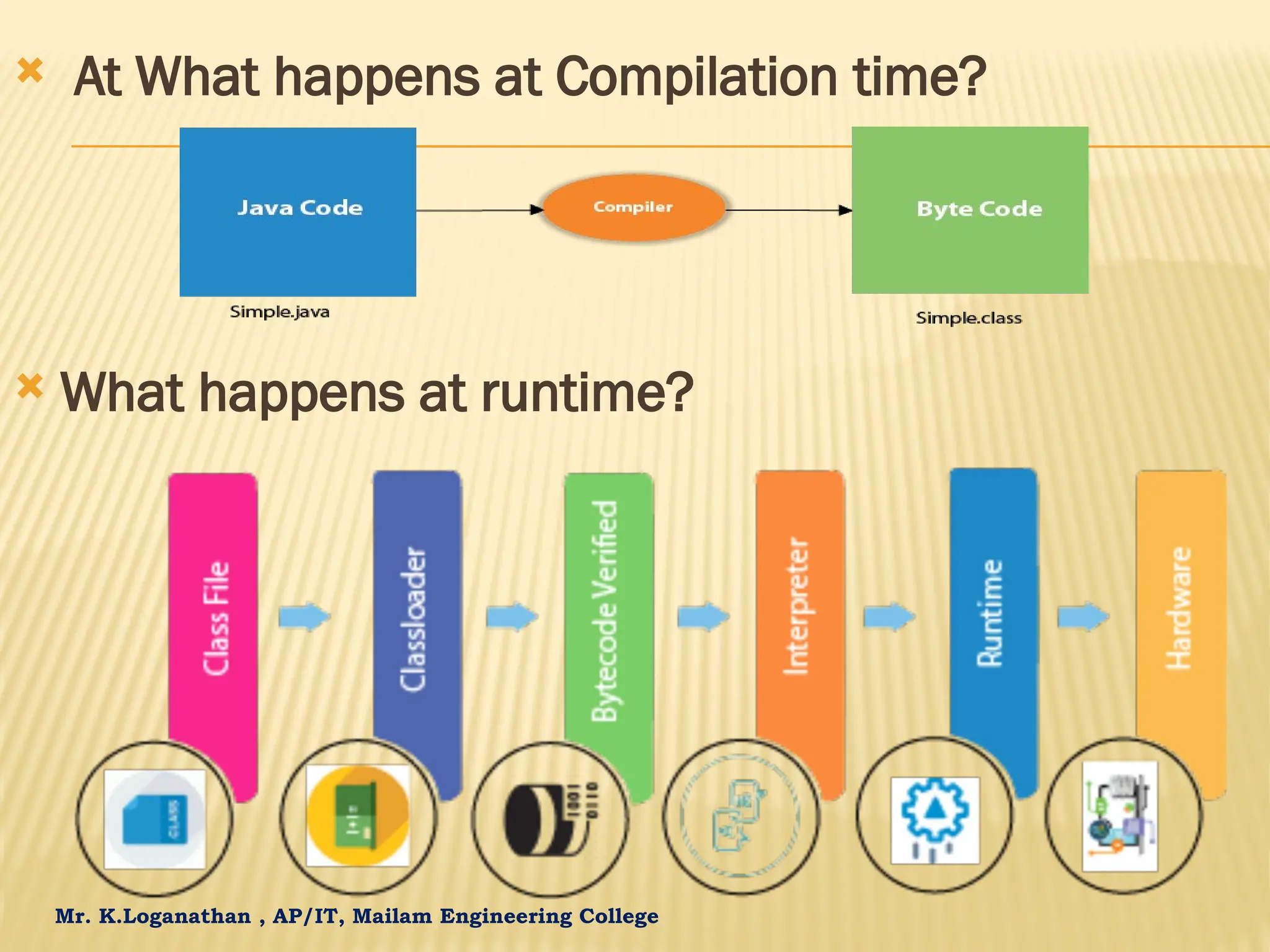

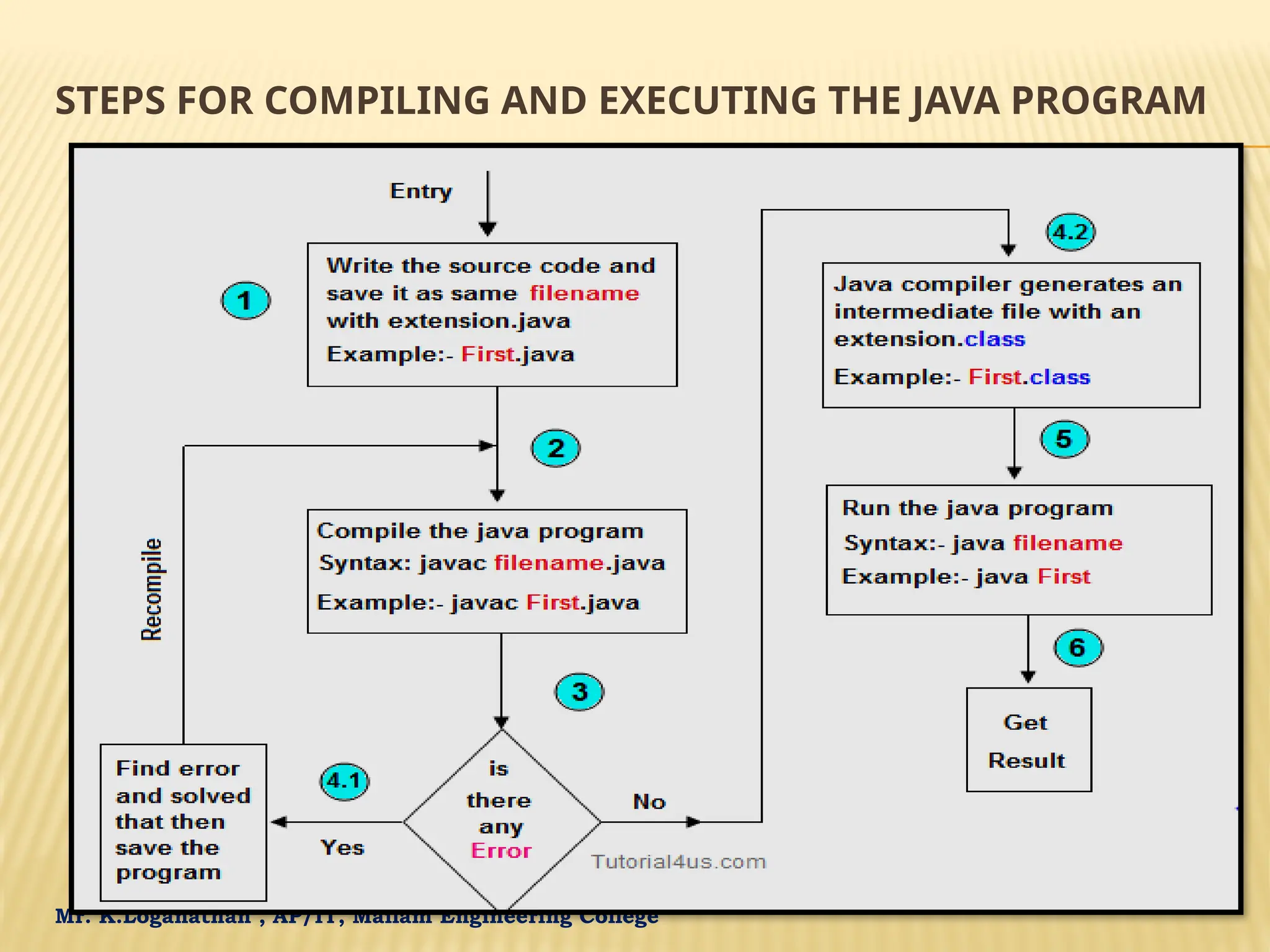
![Mr. K.Loganathan , AP/IT, Mailam Engineering College JAVA VARIABLES Variables are nothing but reserved memory locations to store values. Syntax [data_type] [variable_name] = [variable_value]; E.g: int i = 10; //Variable of int type String str = "howtodoinjava.com"; //Variable of string type Object obj = new Object(); //Variable of object type int[] scores = [1,2,3,4,5,6,7,8,9]; / //Variable of int type](https://image.slidesharecdn.com/oopsunit-12-240820005458-4d788f30/75/CS3391-Object-Oriented-Programming-AU-Reg-2021-24-2048.jpg)
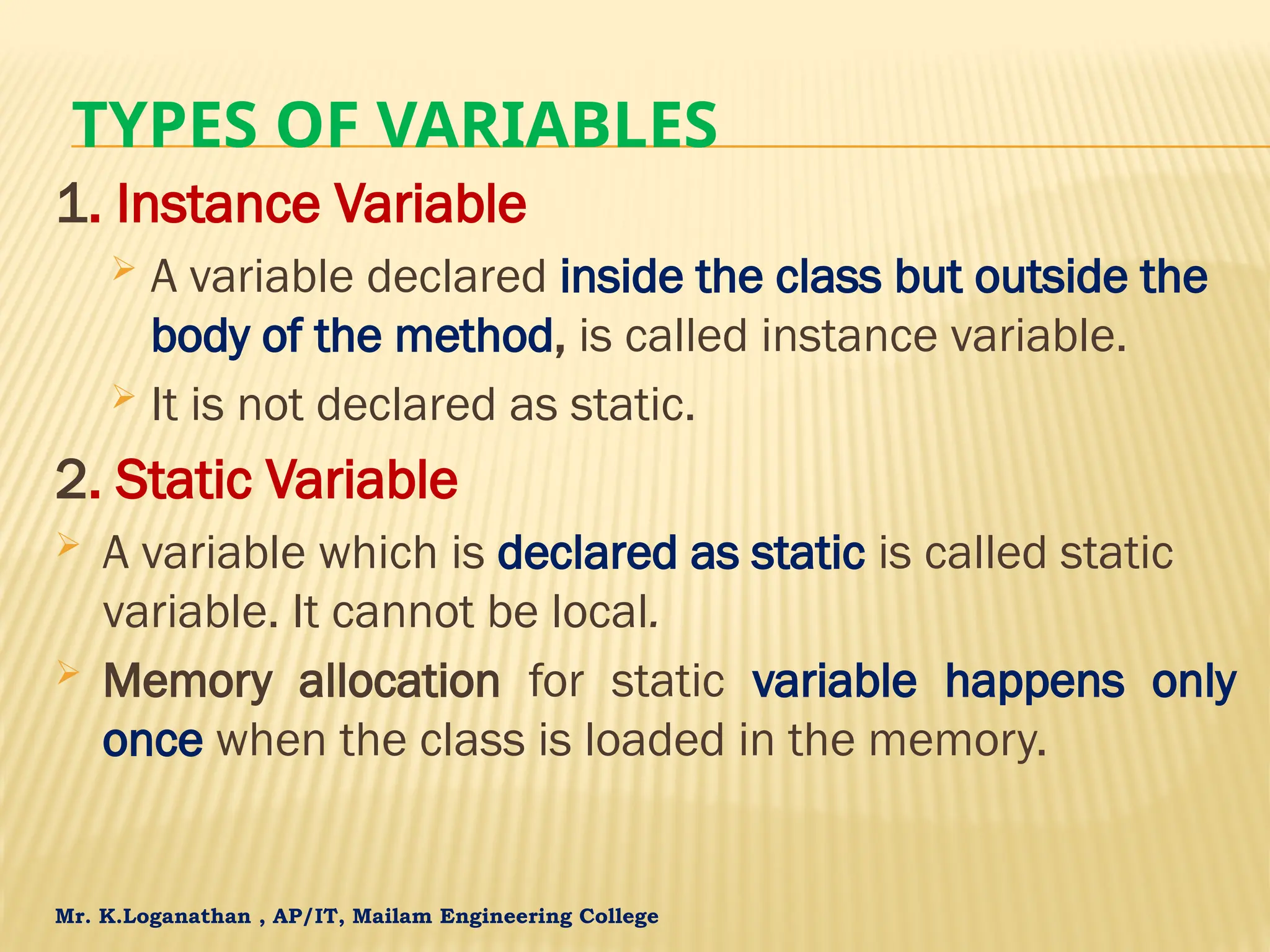

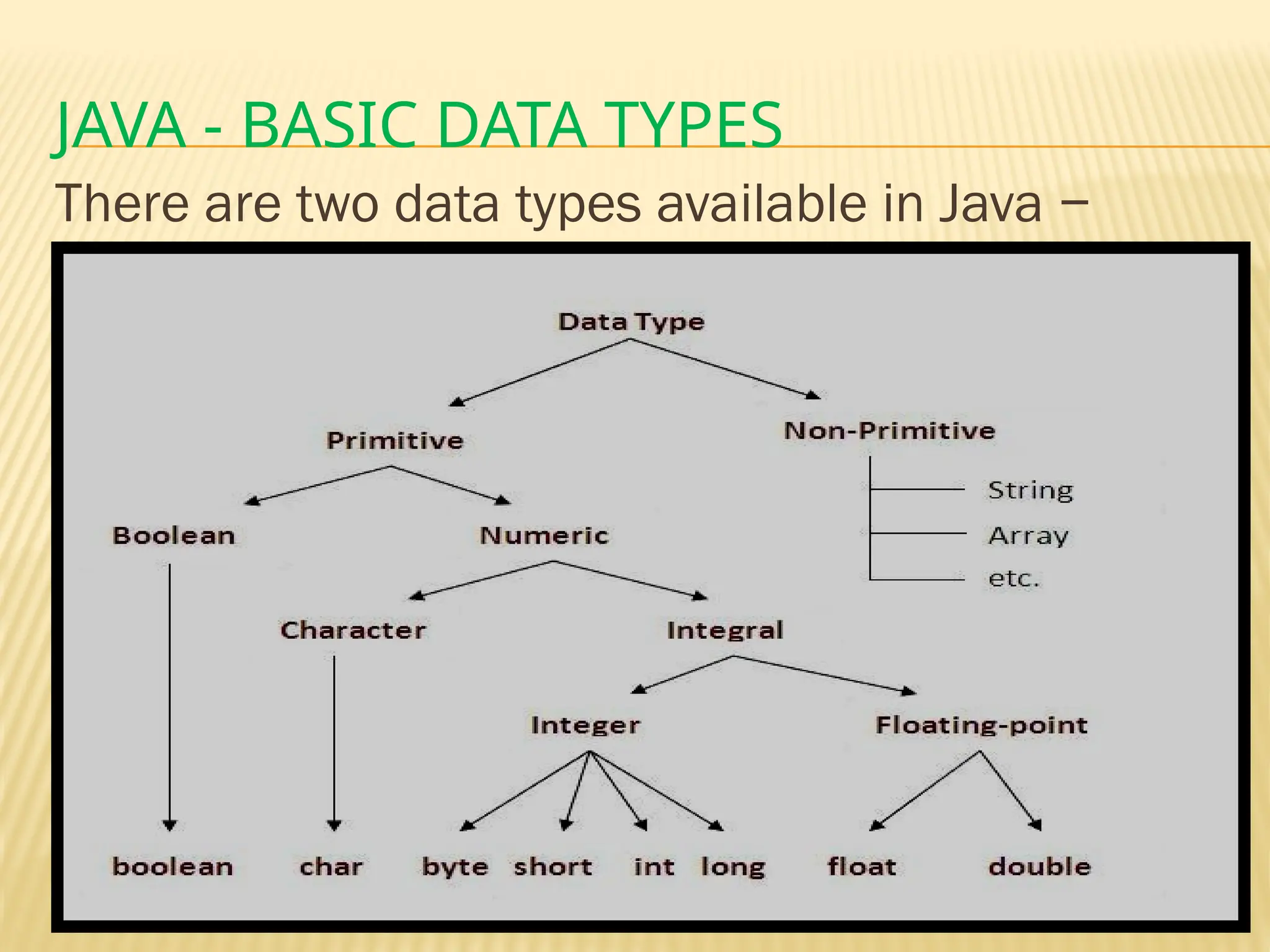
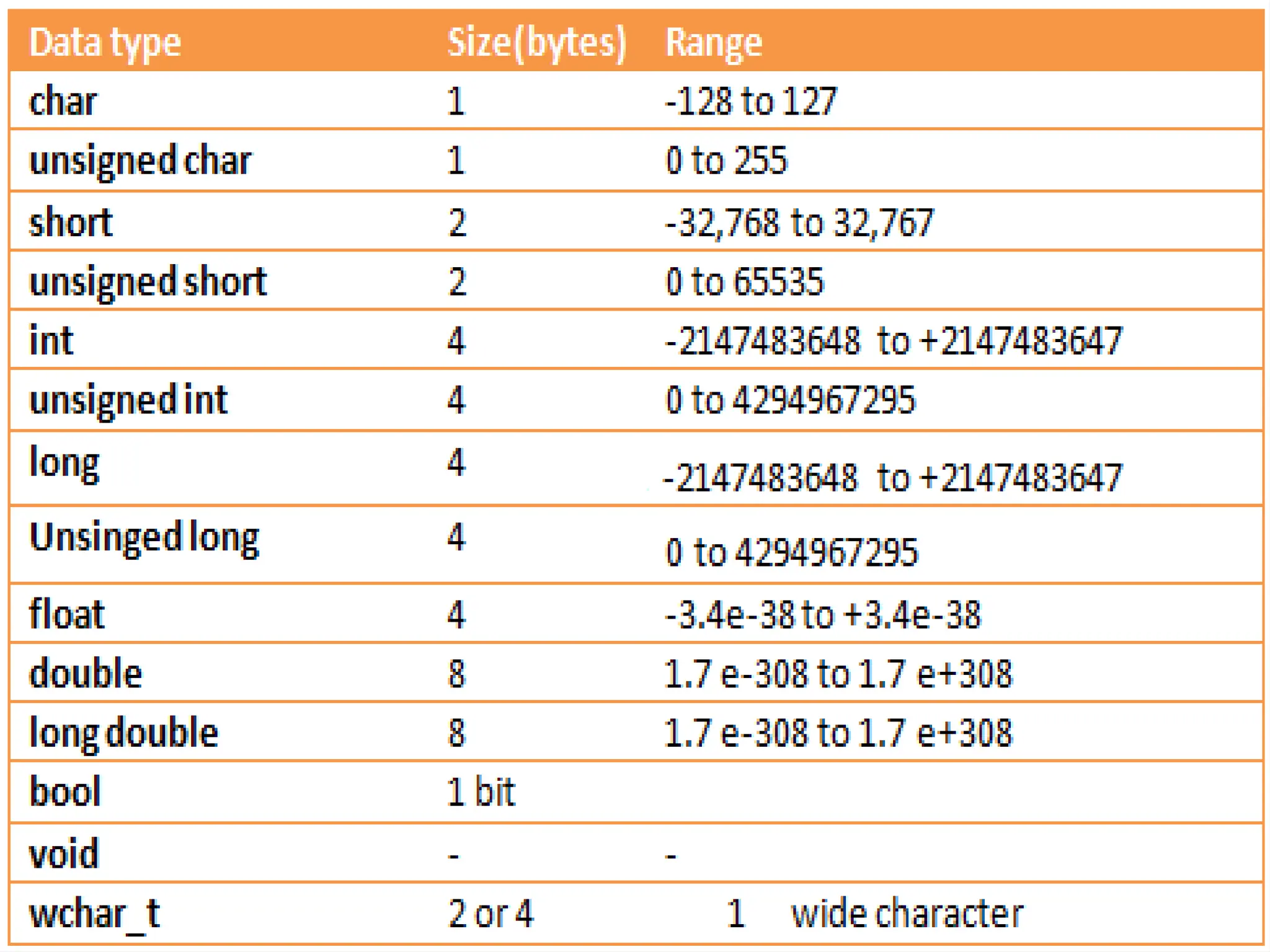
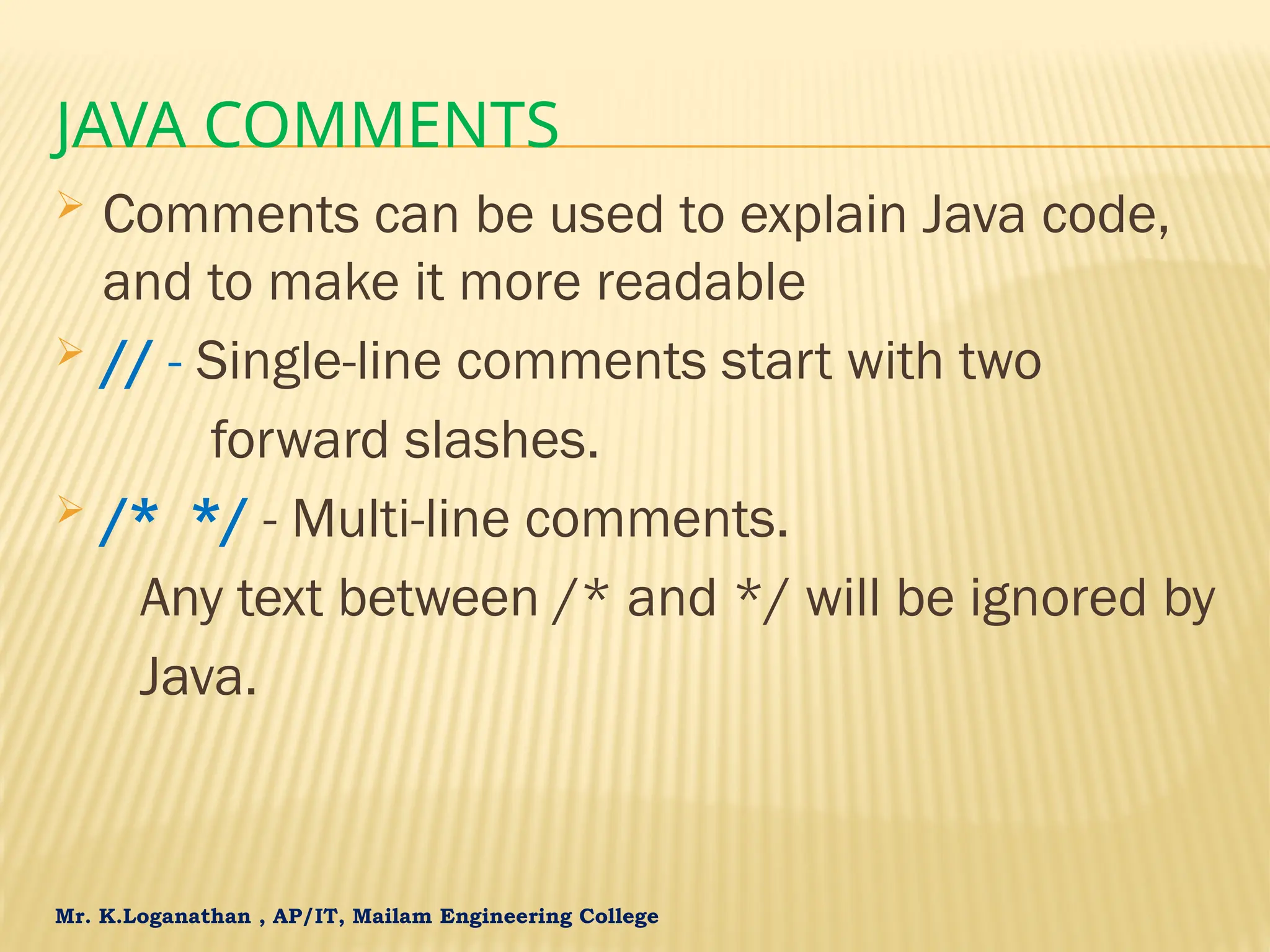
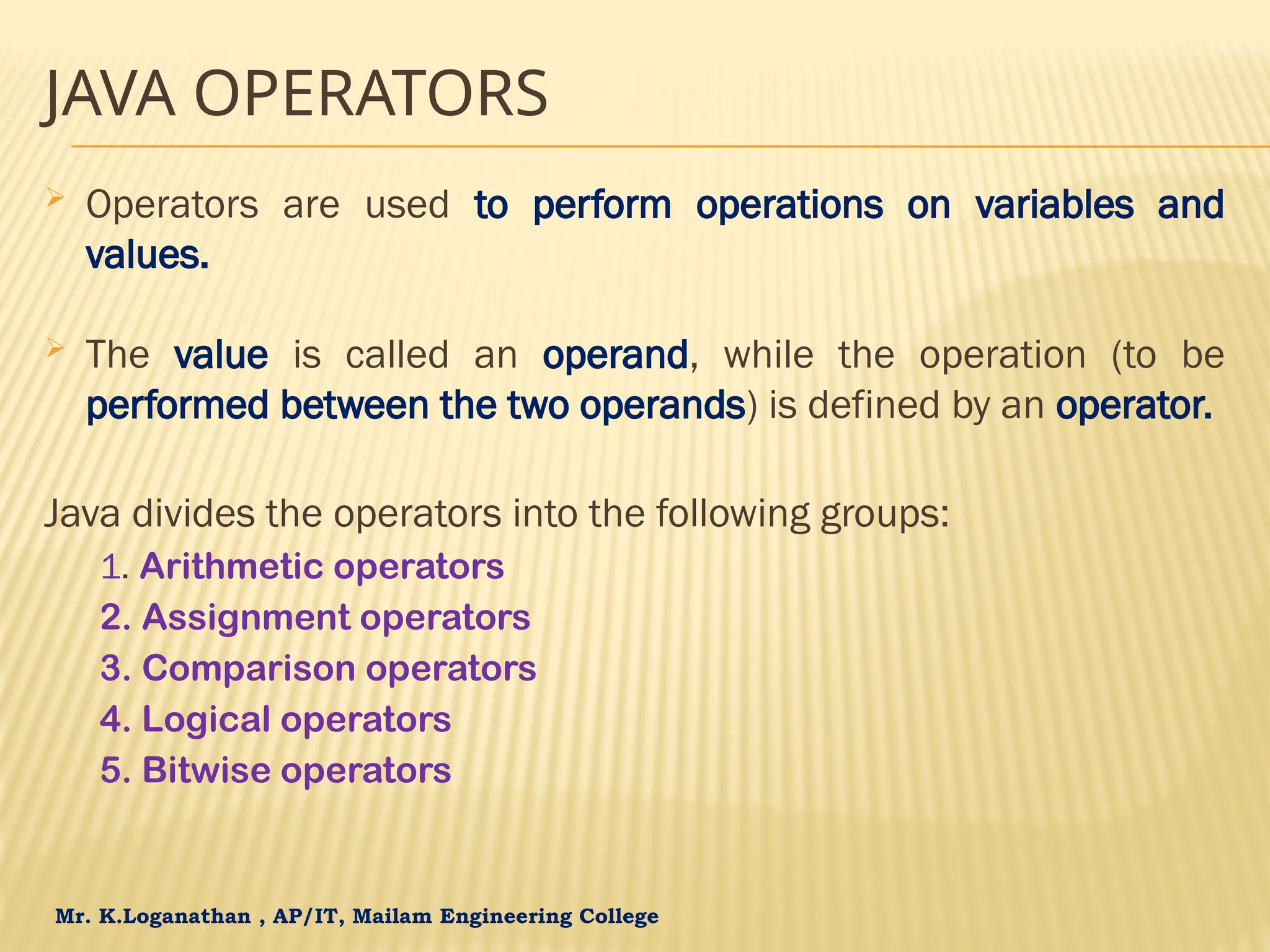
![Mr. K.Loganathan , AP/IT, Mailam Engineering College 1. Arithmetic Operators Arithmetic operators are used to perform common mathematical operations. Example: public class MyClass { public static void main(String[] args) { int x = 5; int y = 3; System.out.println(x + y); } }](https://image.slidesharecdn.com/oopsunit-12-240820005458-4d788f30/75/CS3391-Object-Oriented-Programming-AU-Reg-2021-31-2048.jpg)
![Mr. K.Loganathan , AP/IT, Mailam Engineering College 2. Assignment Operators Assignment operators are used to assign values to variables. public class MyClass { public static void main(String[] args) { int x = 5; x += 3; System.out.println(x); } }](https://image.slidesharecdn.com/oopsunit-12-240820005458-4d788f30/75/CS3391-Object-Oriented-Programming-AU-Reg-2021-32-2048.jpg)
![Mr. K.Loganathan , AP/IT, Mailam Engineering College 3. COMPARISON OPERATORS Comparison operators are used to compare two values. public class MyClass { public static void main(String[] args) { int x = 5; int y = 3; System.out.println(x == y);}](https://image.slidesharecdn.com/oopsunit-12-240820005458-4d788f30/75/CS3391-Object-Oriented-Programming-AU-Reg-2021-33-2048.jpg)
![Mr. K.Loganathan , AP/IT, Mailam Engineering College 4. LOGICAL OPERATORS Logical operators are used to determine the logic between variables or values. public class MyClass { public static void main(String[] args) { int x = 5; System.out.println(x > 3 && x < 10); }](https://image.slidesharecdn.com/oopsunit-12-240820005458-4d788f30/75/CS3391-Object-Oriented-Programming-AU-Reg-2021-34-2048.jpg)

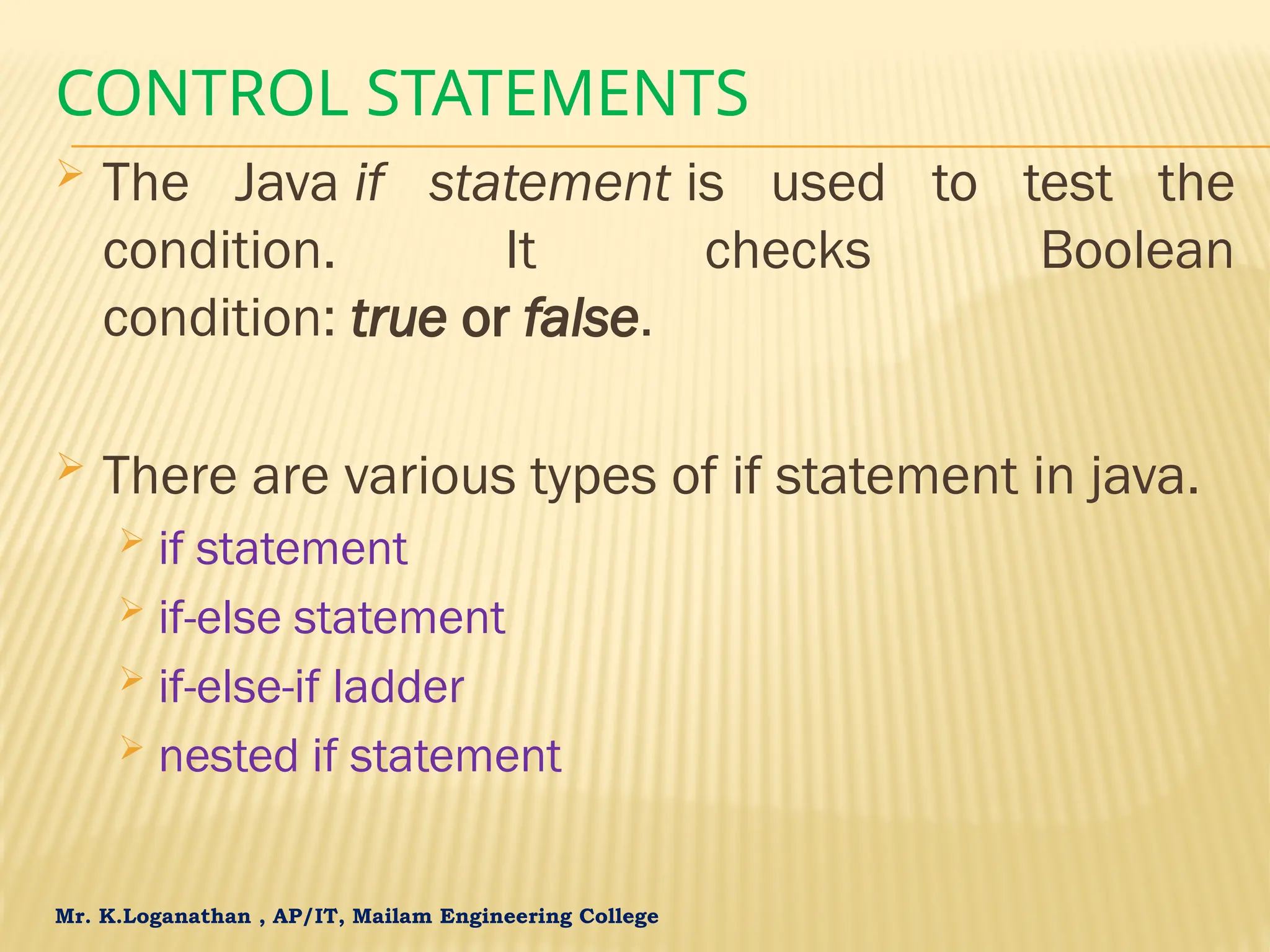
![Mr. K.Loganathan , AP/IT, Mailam Engineering College SIMPLE IF STATEMENT It executes the if block if condition is true. Syntax: if(condition) { True Statemetns; } Example: Class Great { Public static void main(String args[]) { int a = 10, b = 5; if(a>b) { System.out.println(“a is greater than b”); } } }](https://image.slidesharecdn.com/oopsunit-12-240820005458-4d788f30/75/CS3391-Object-Oriented-Programming-AU-Reg-2021-37-2048.jpg)
![Mr. K.Loganathan , AP/IT, Mailam Engineering College IF-ELSE STATEMENT It executes the if block if condition is true otherwise else block is executed Syntax: if(condition) { //code if condition is true }else { //code if condition is false } Example: public class Example { public static void main(String[] args) { int a=13; int b-20; if(a>b){ System.out.println(“A is big number"); }else{ System.out.println(“B is big number"); } } }](https://image.slidesharecdn.com/oopsunit-12-240820005458-4d788f30/75/CS3391-Object-Oriented-Programming-AU-Reg-2021-38-2048.jpg)
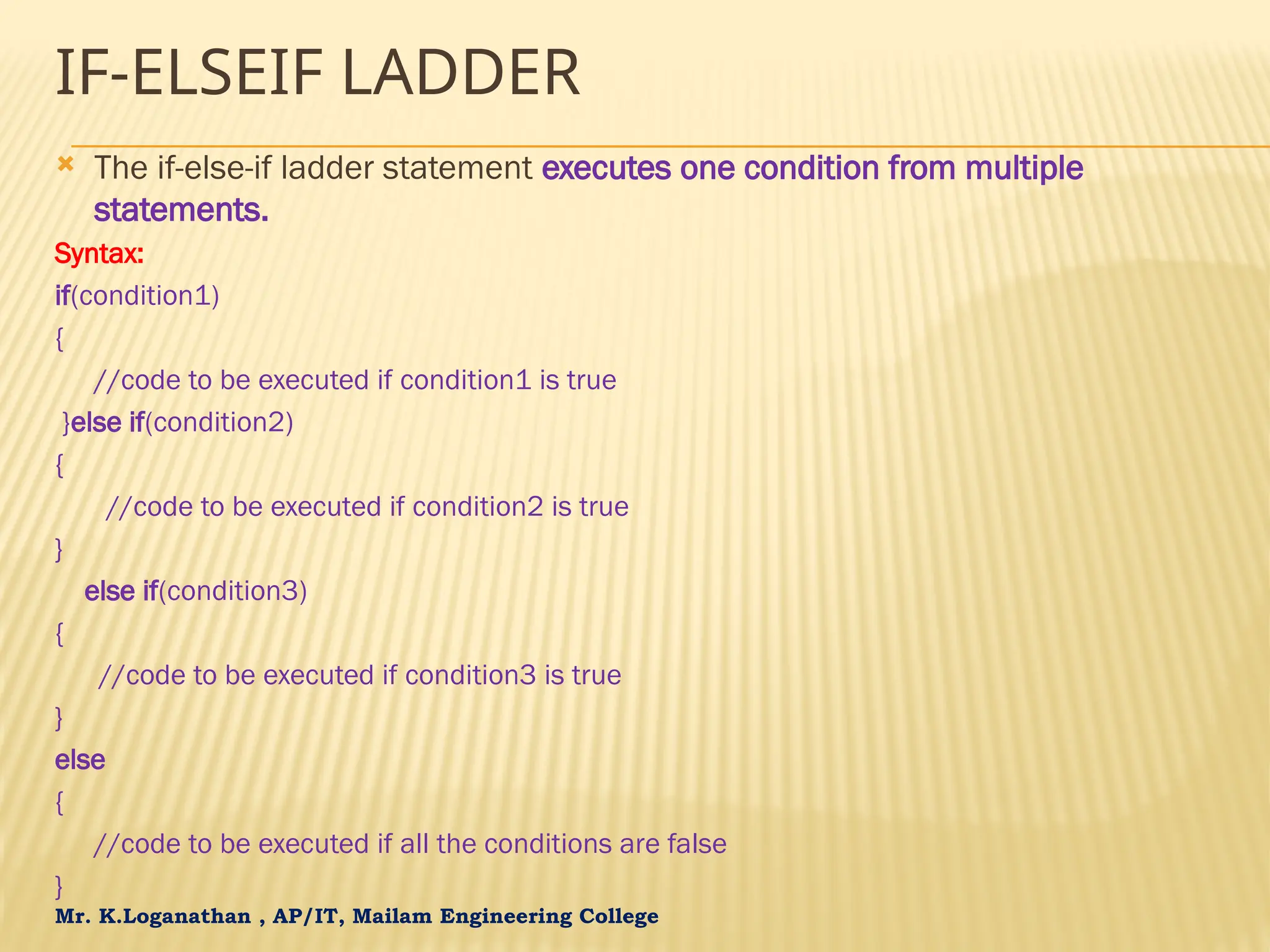
![Mr. K.Loganathan , AP/IT, Mailam Engineering College EXAMPLE public class Example { public static void main(String[] args) { int a=13; int b=20, int c=30; if(a>b)&&(a>c) { System.out.println(“A is big number"); } elseif(b>c) { System.out.println(“B is big number"); } else { System.out.println(“Cis big number"); } } }](https://image.slidesharecdn.com/oopsunit-12-240820005458-4d788f30/75/CS3391-Object-Oriented-Programming-AU-Reg-2021-40-2048.jpg)
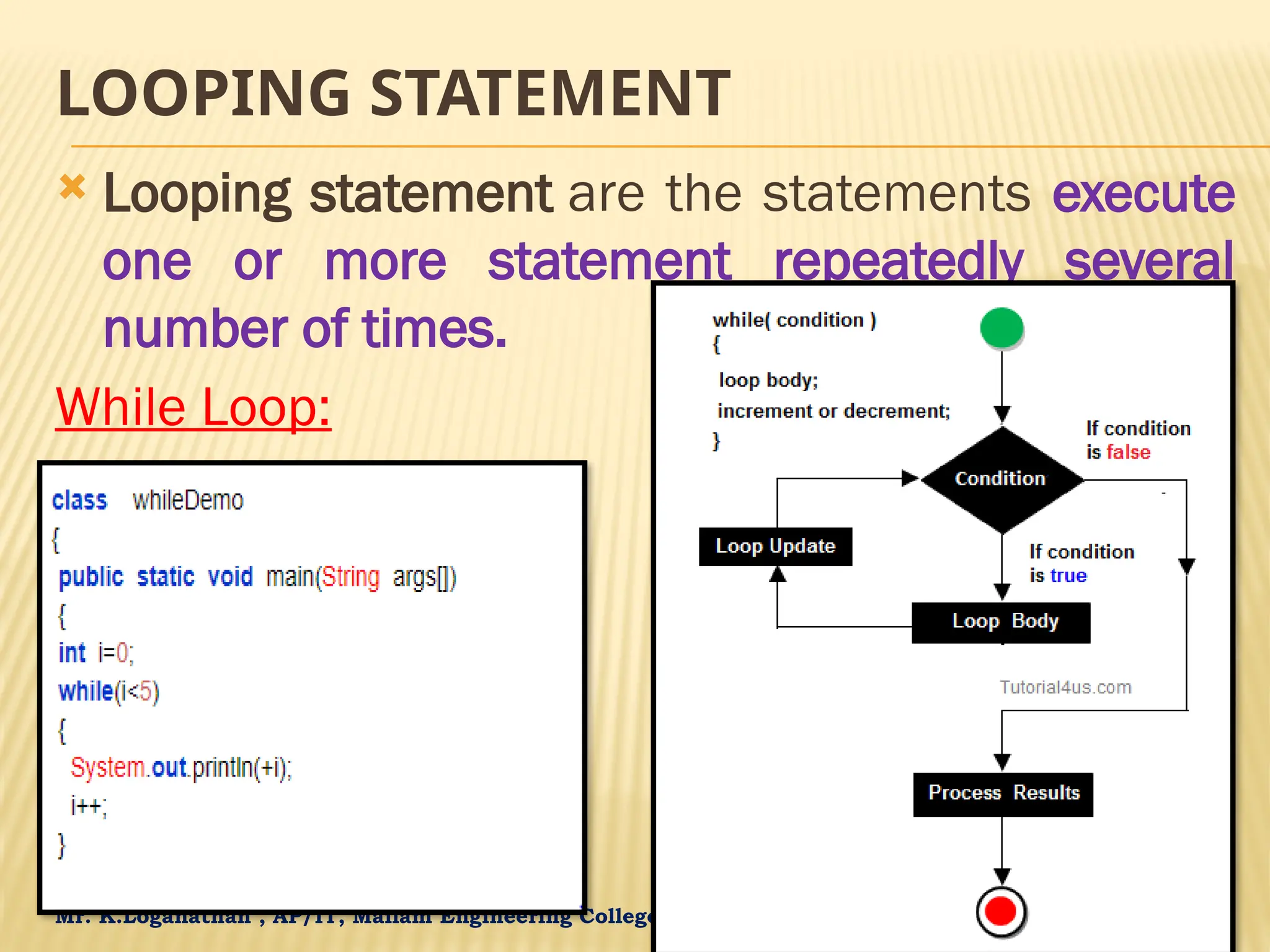
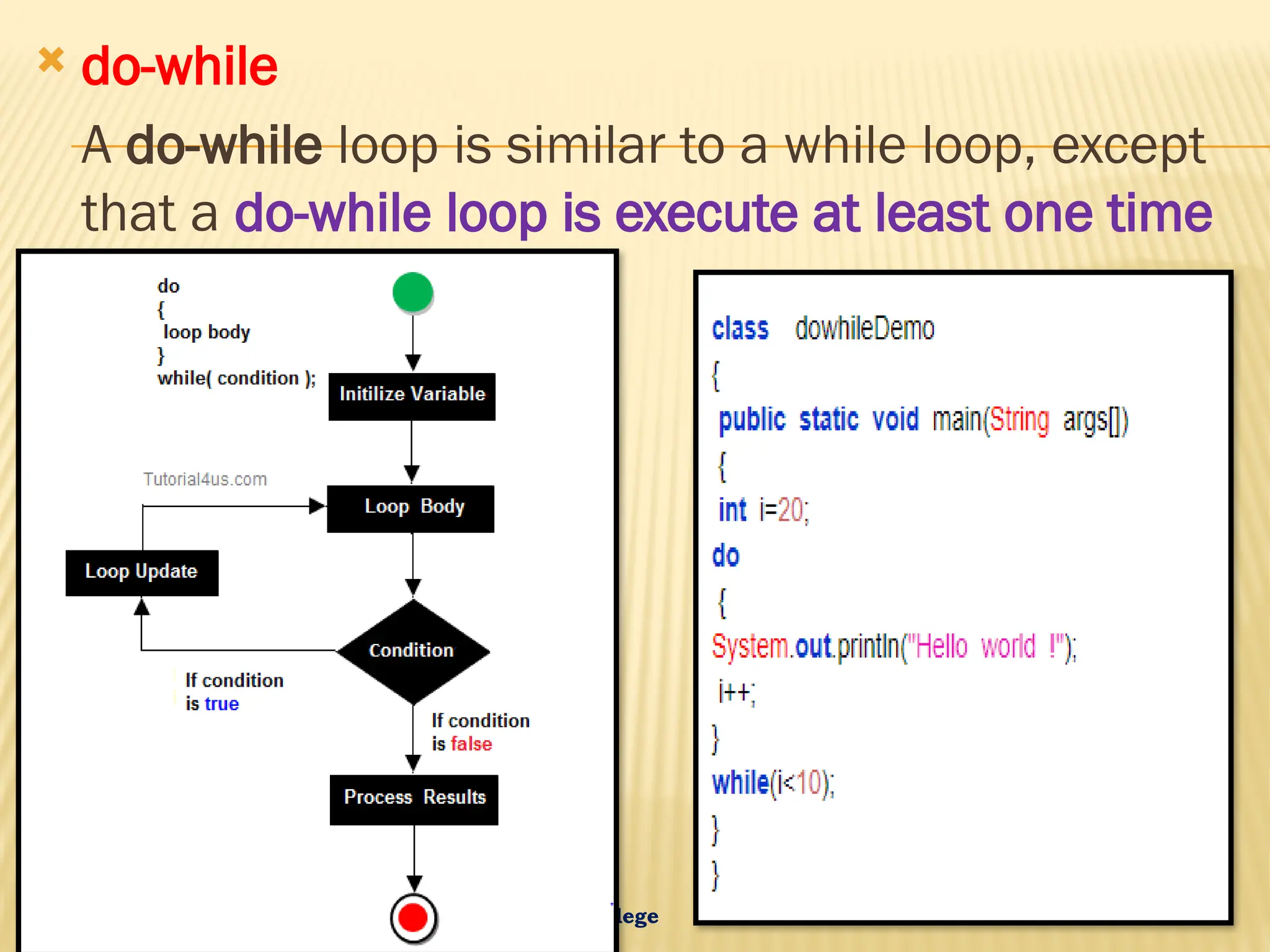


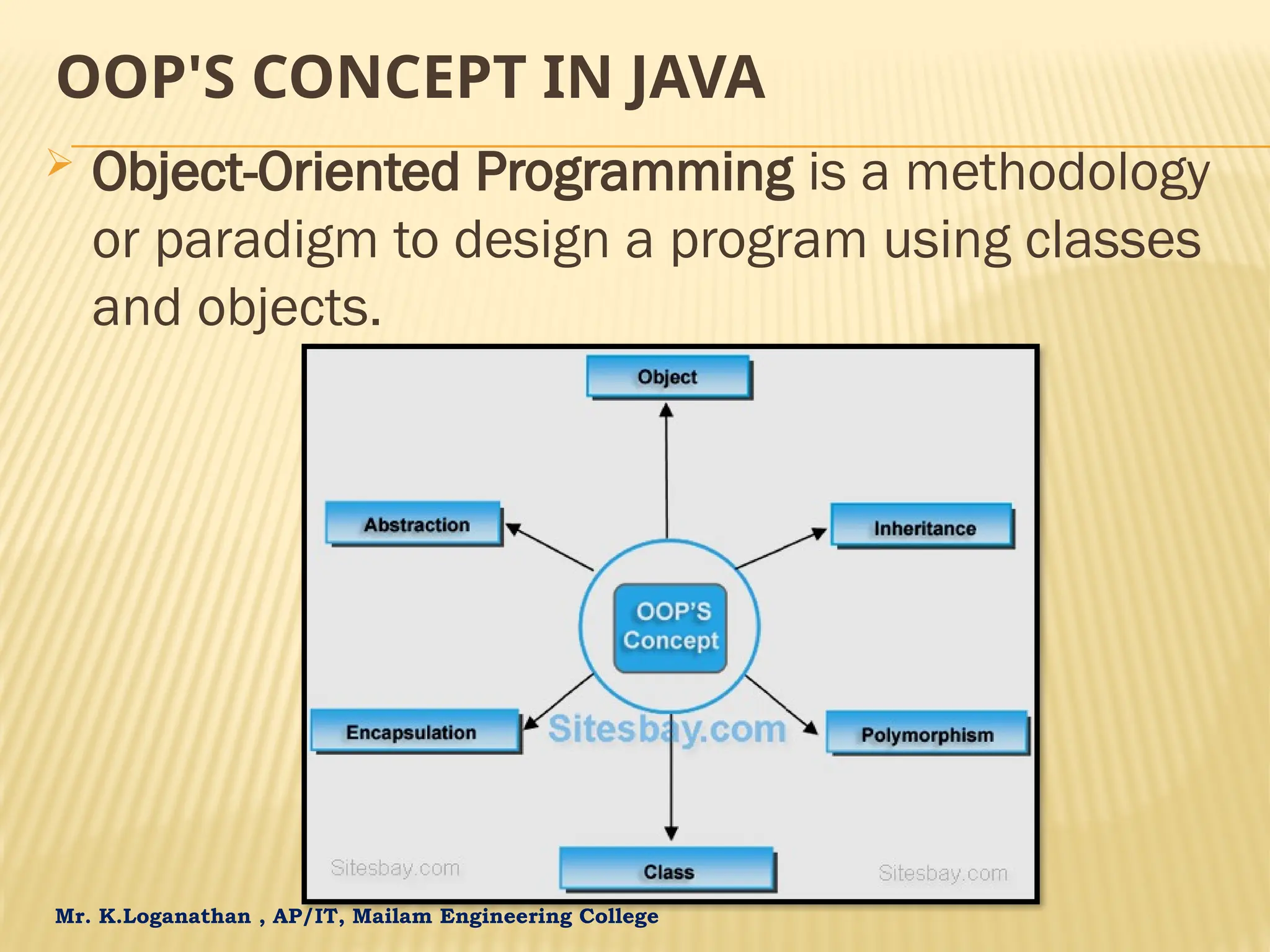
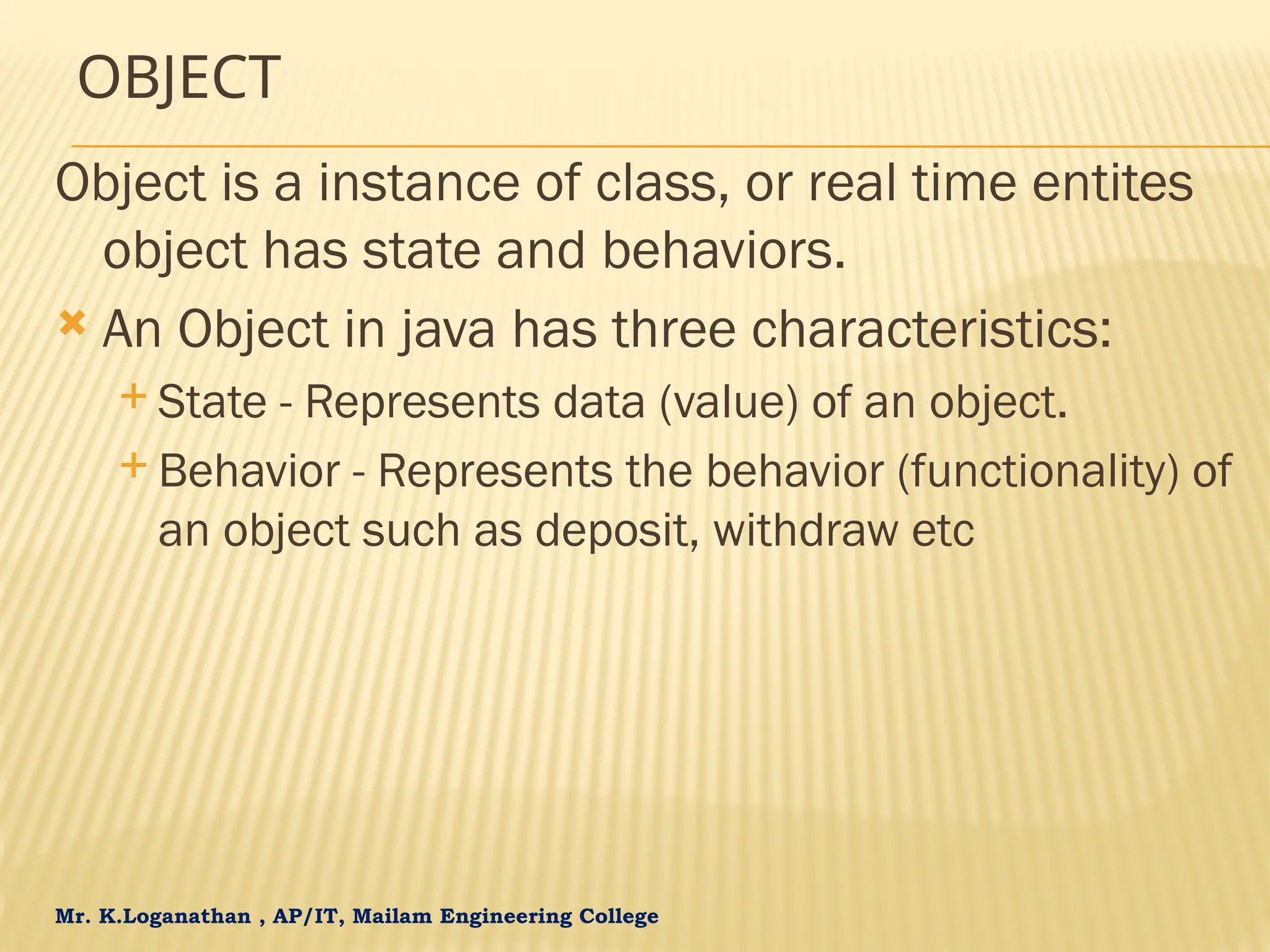

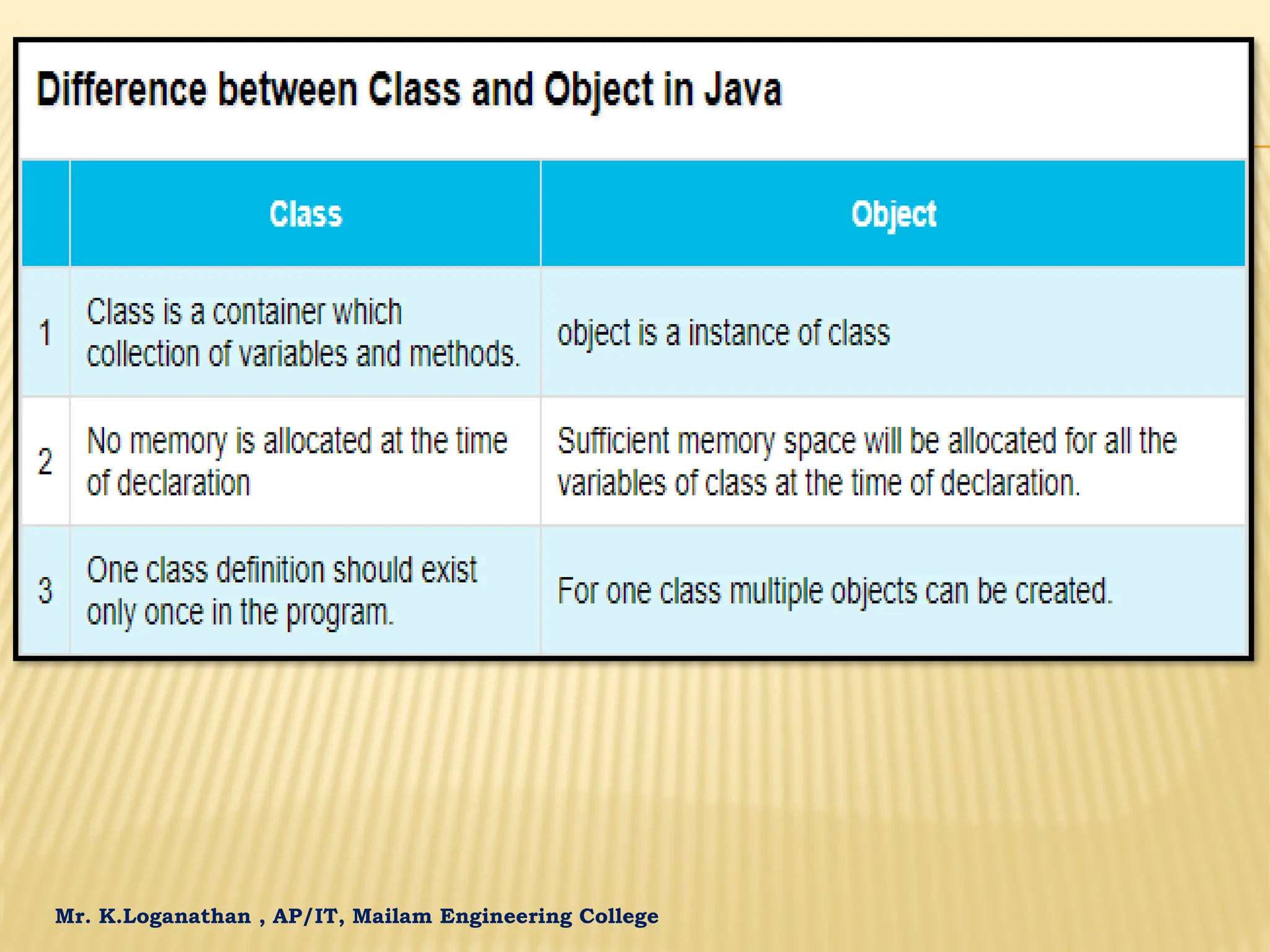
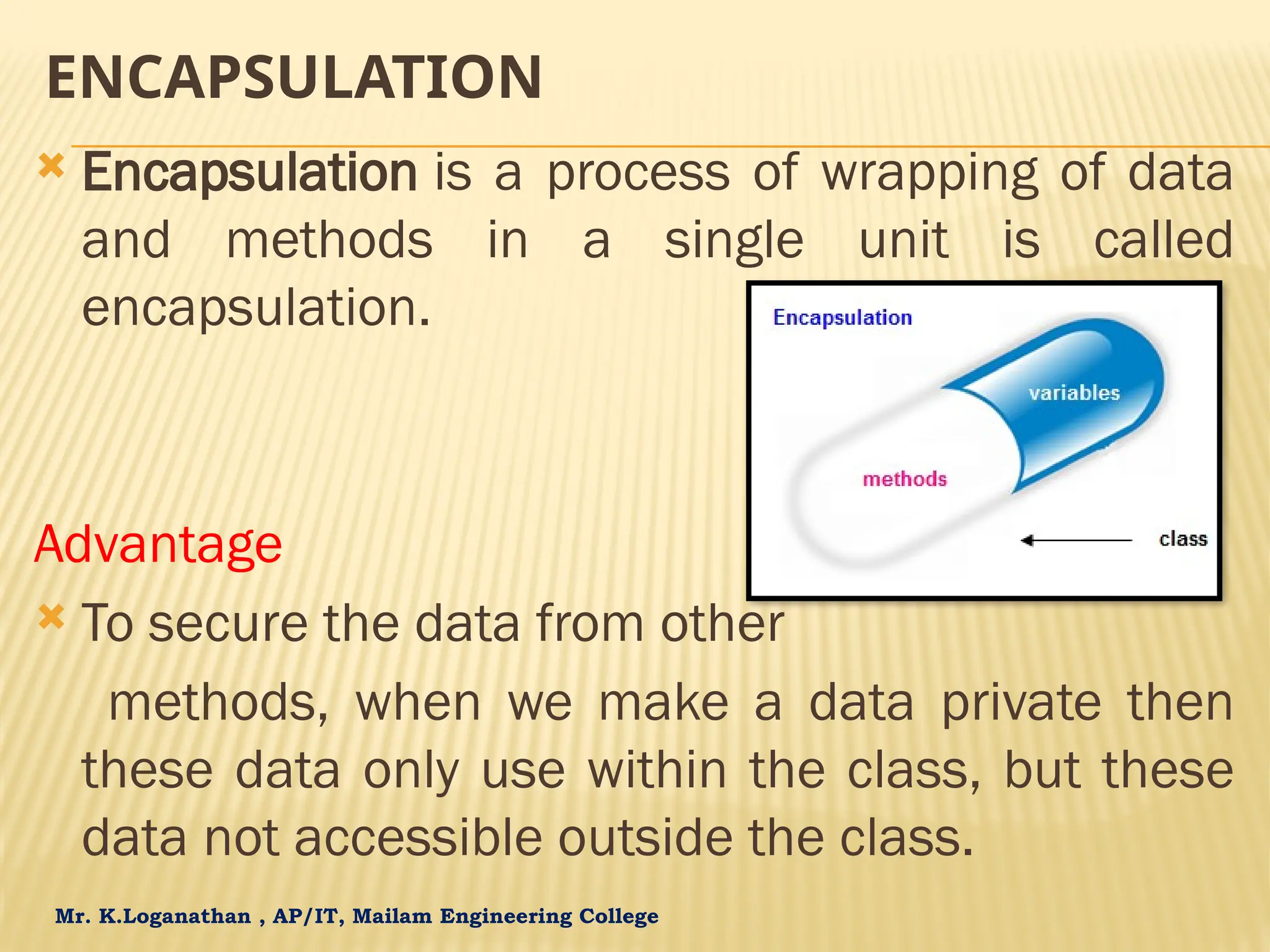
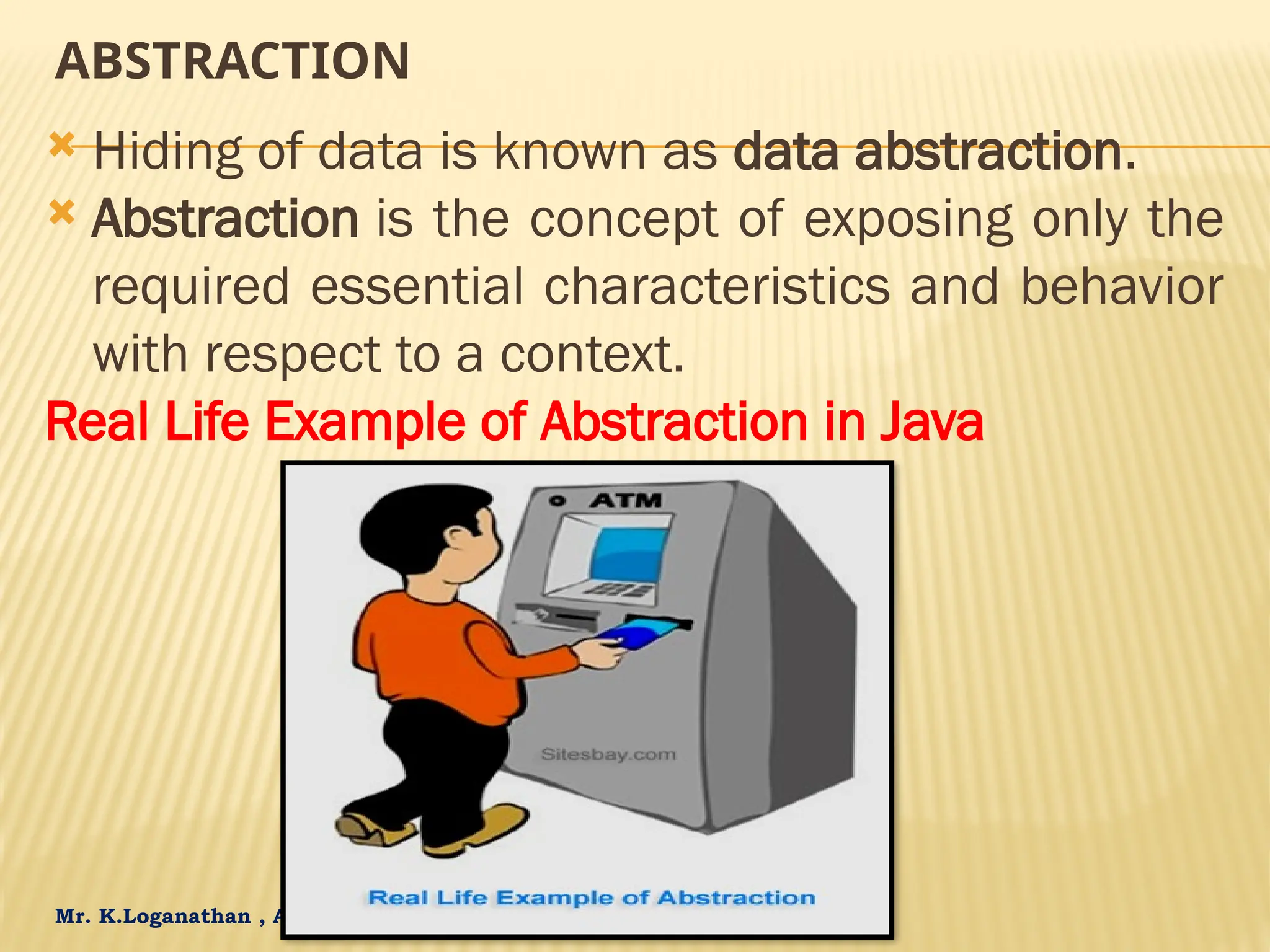
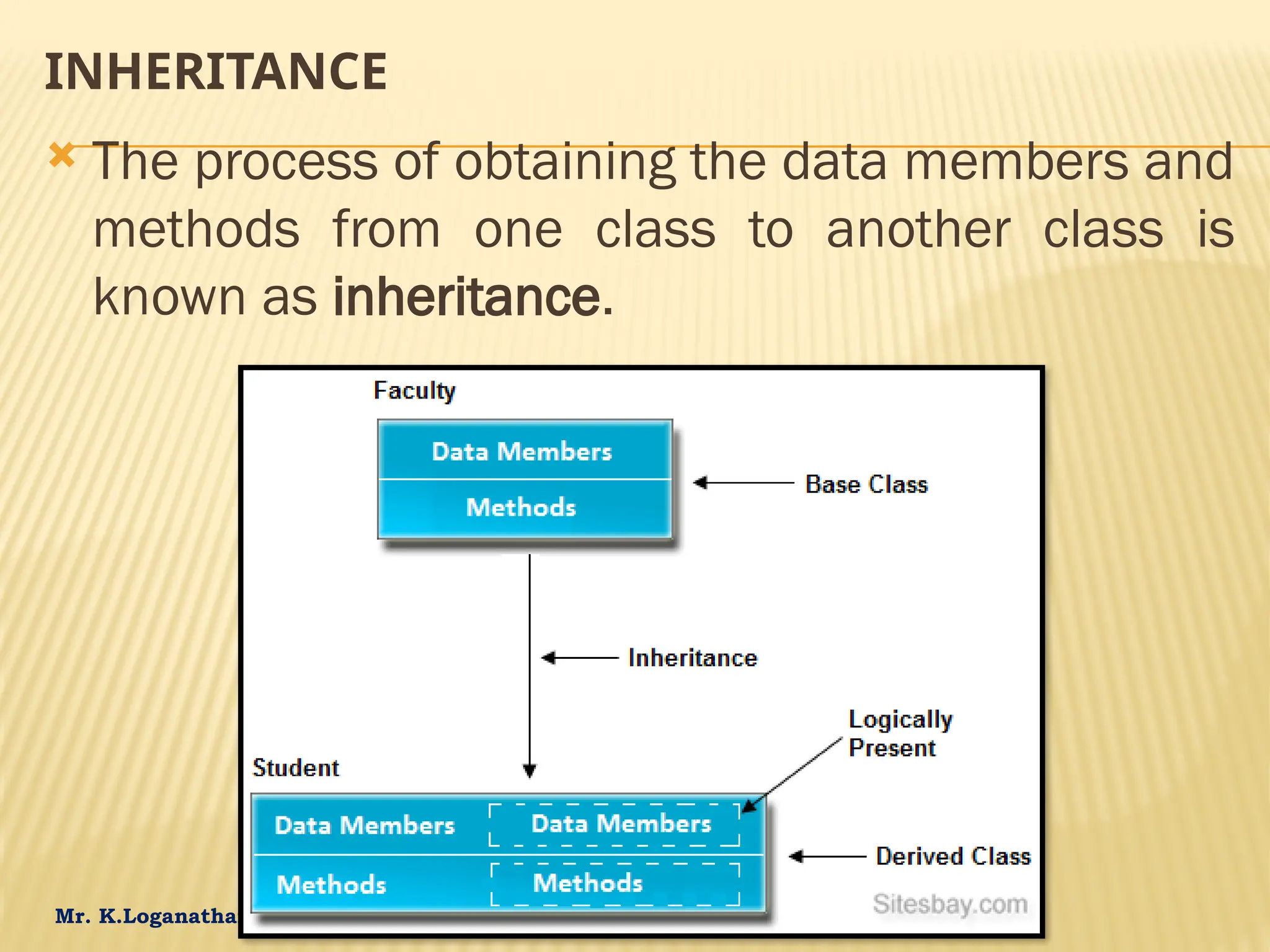
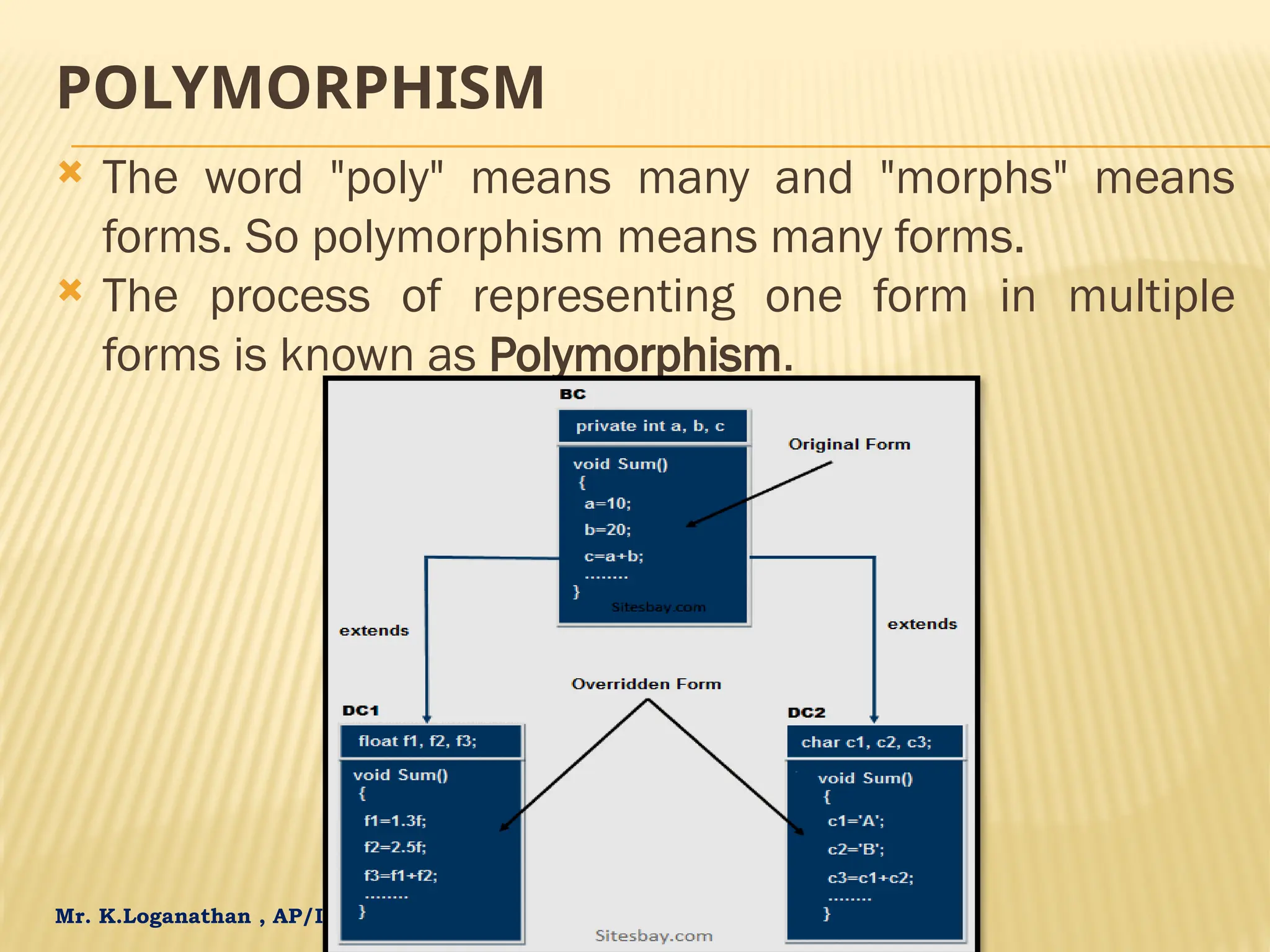



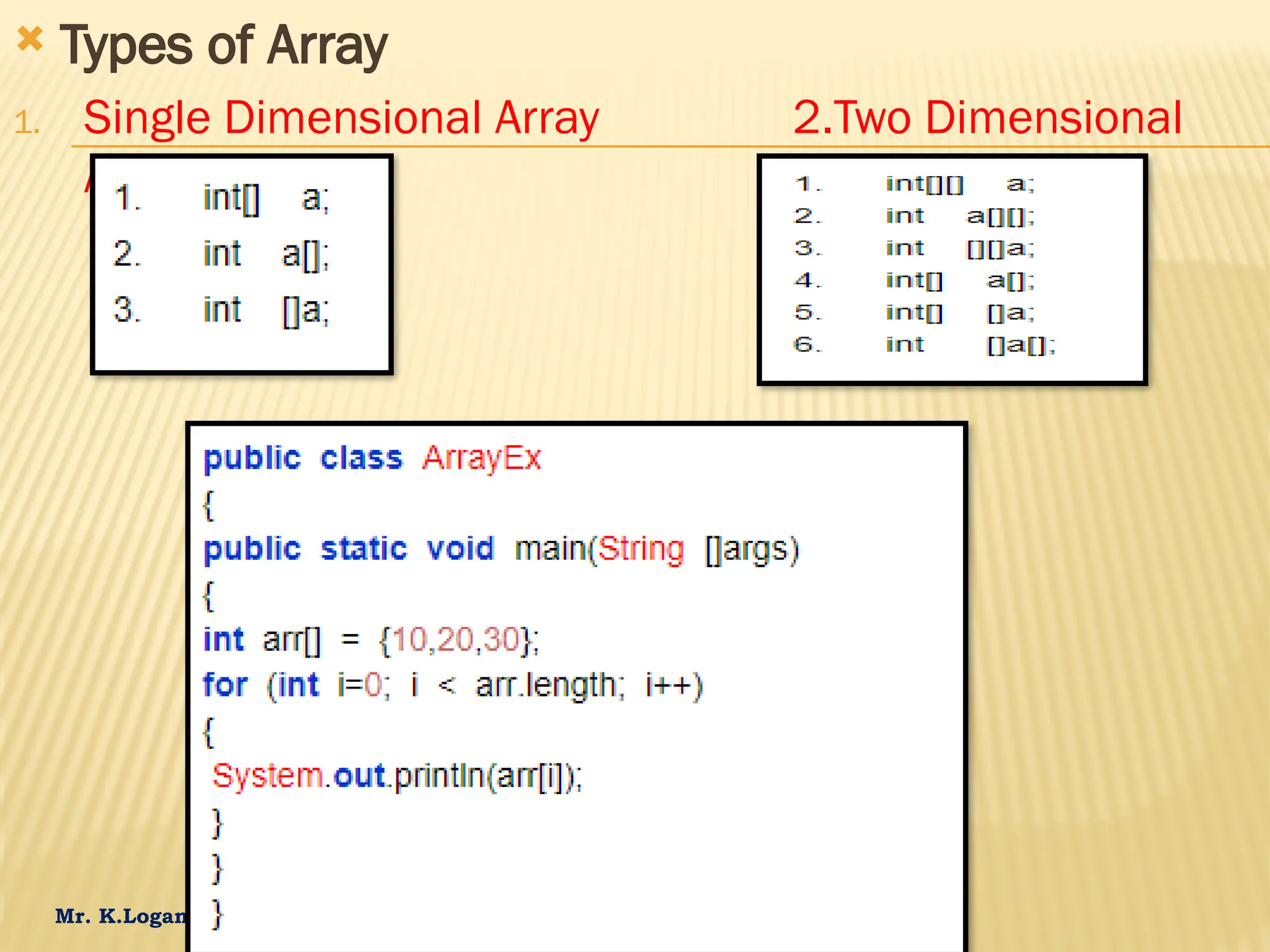
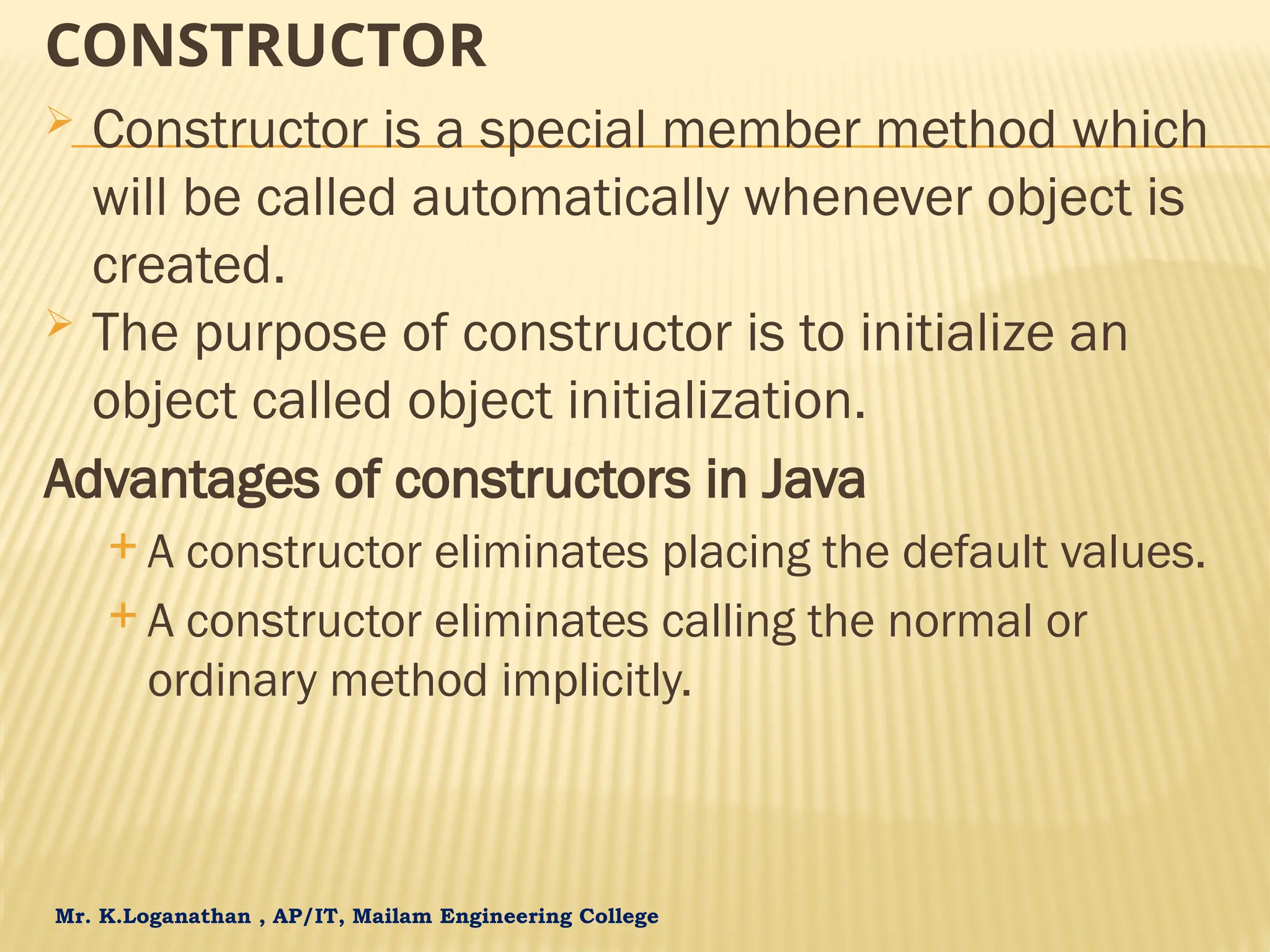


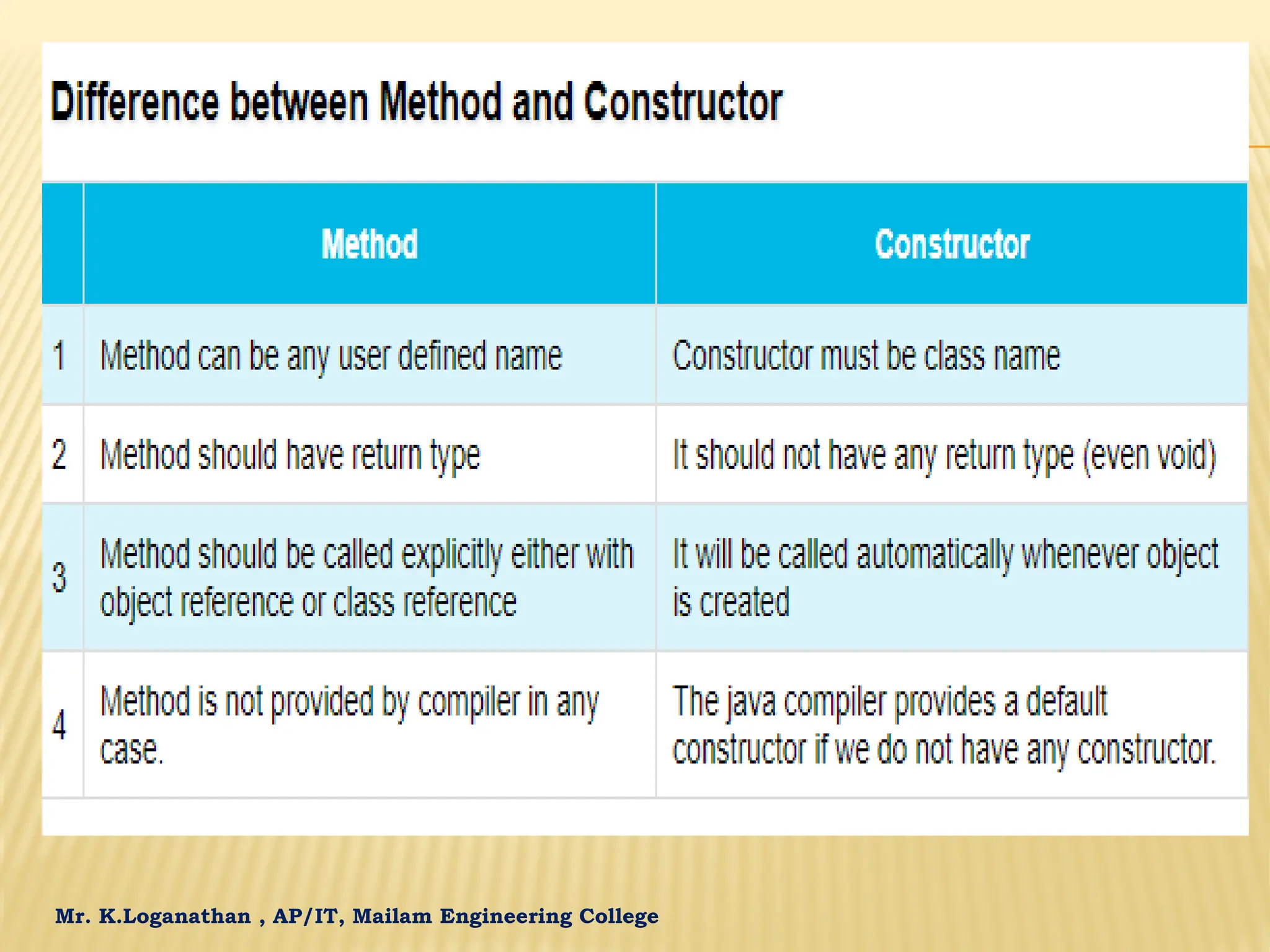
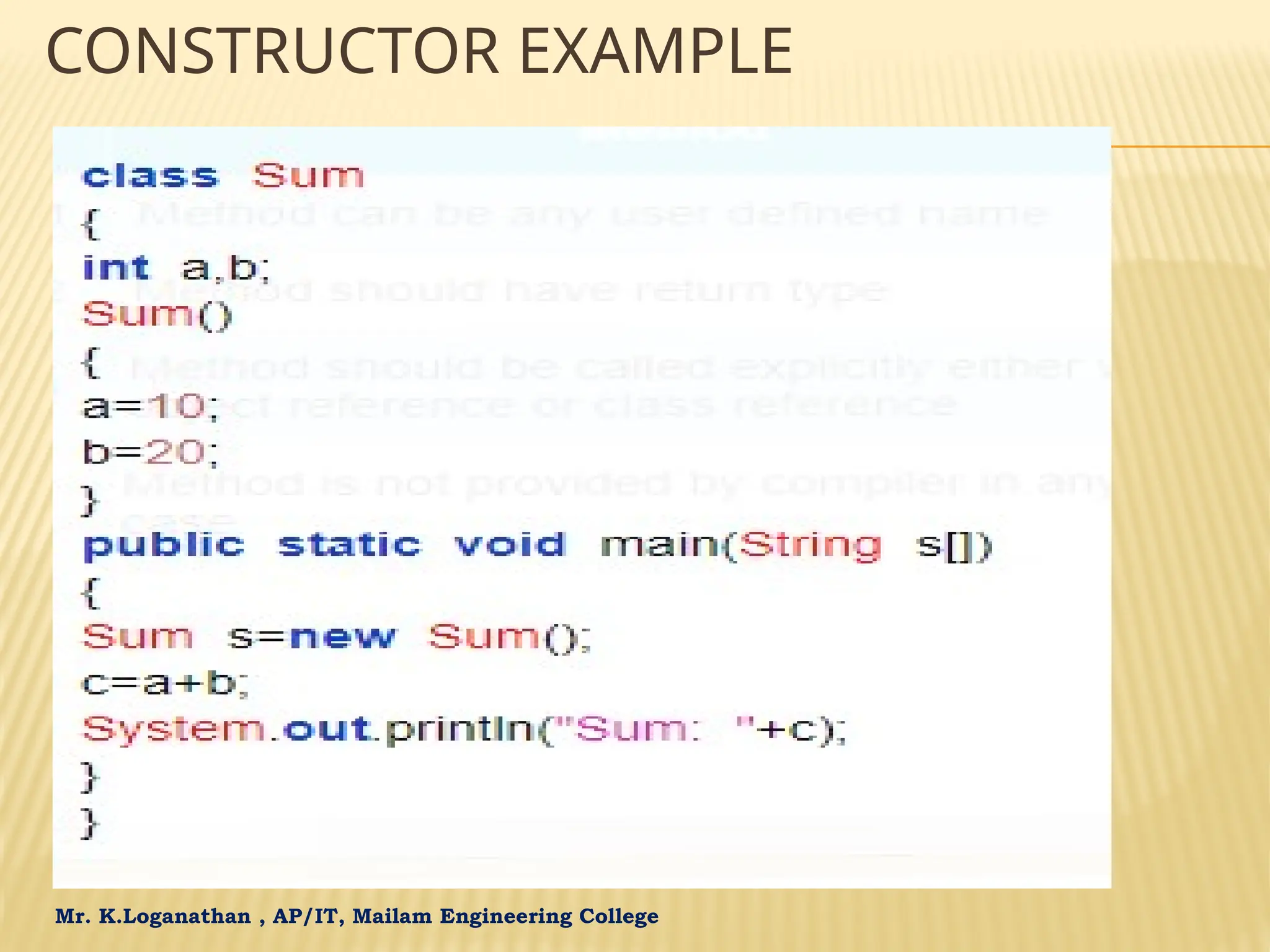
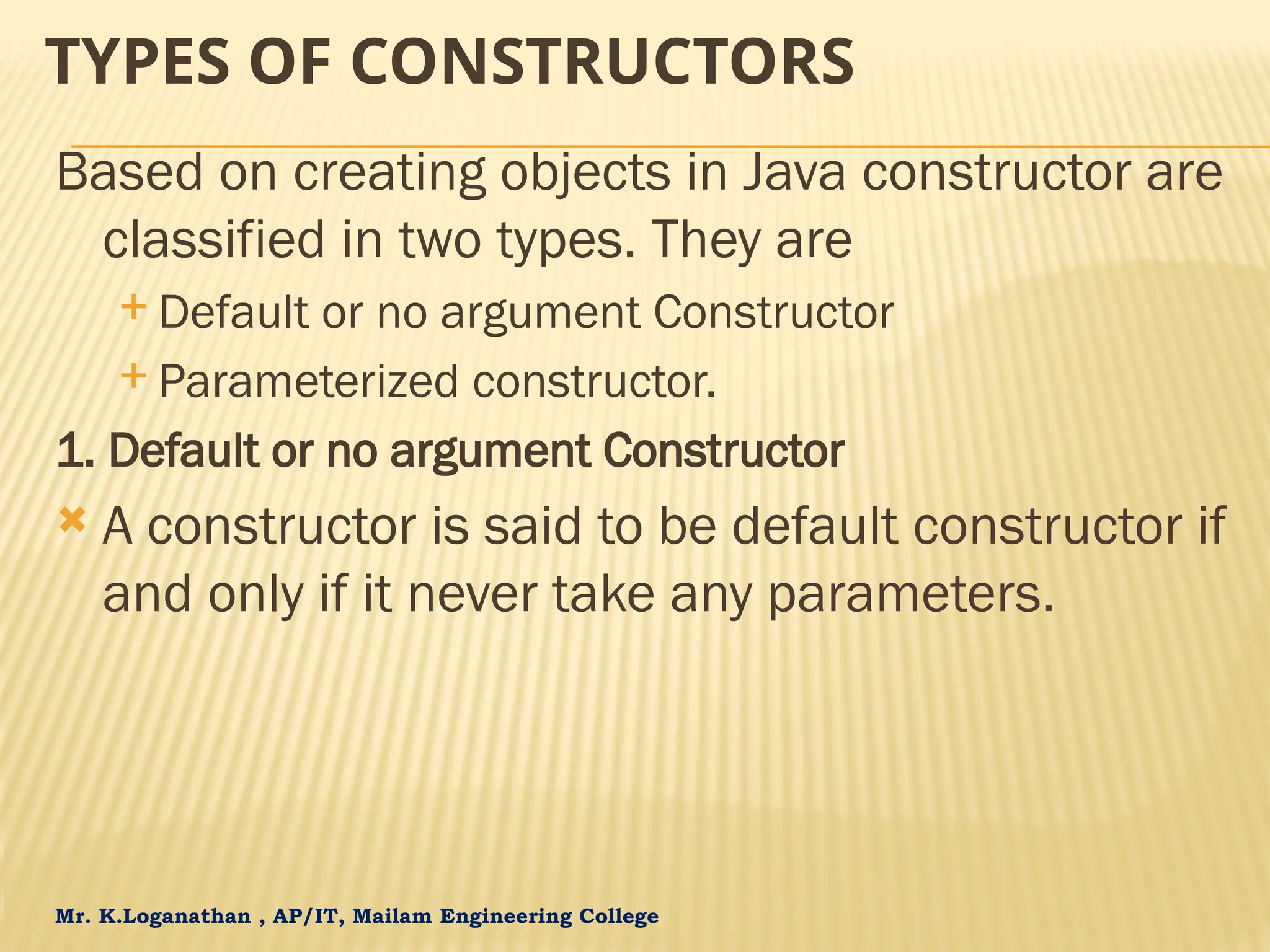
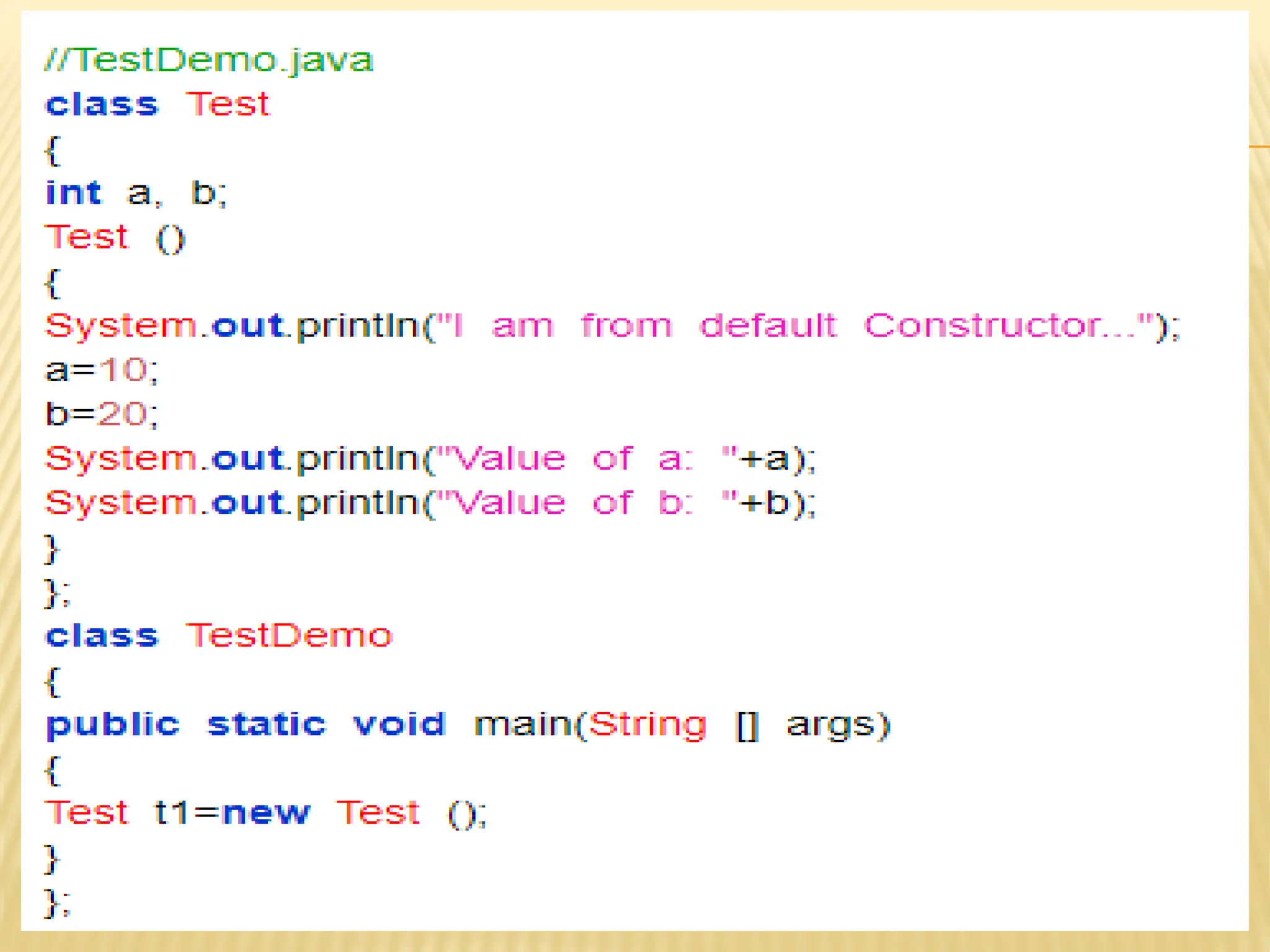


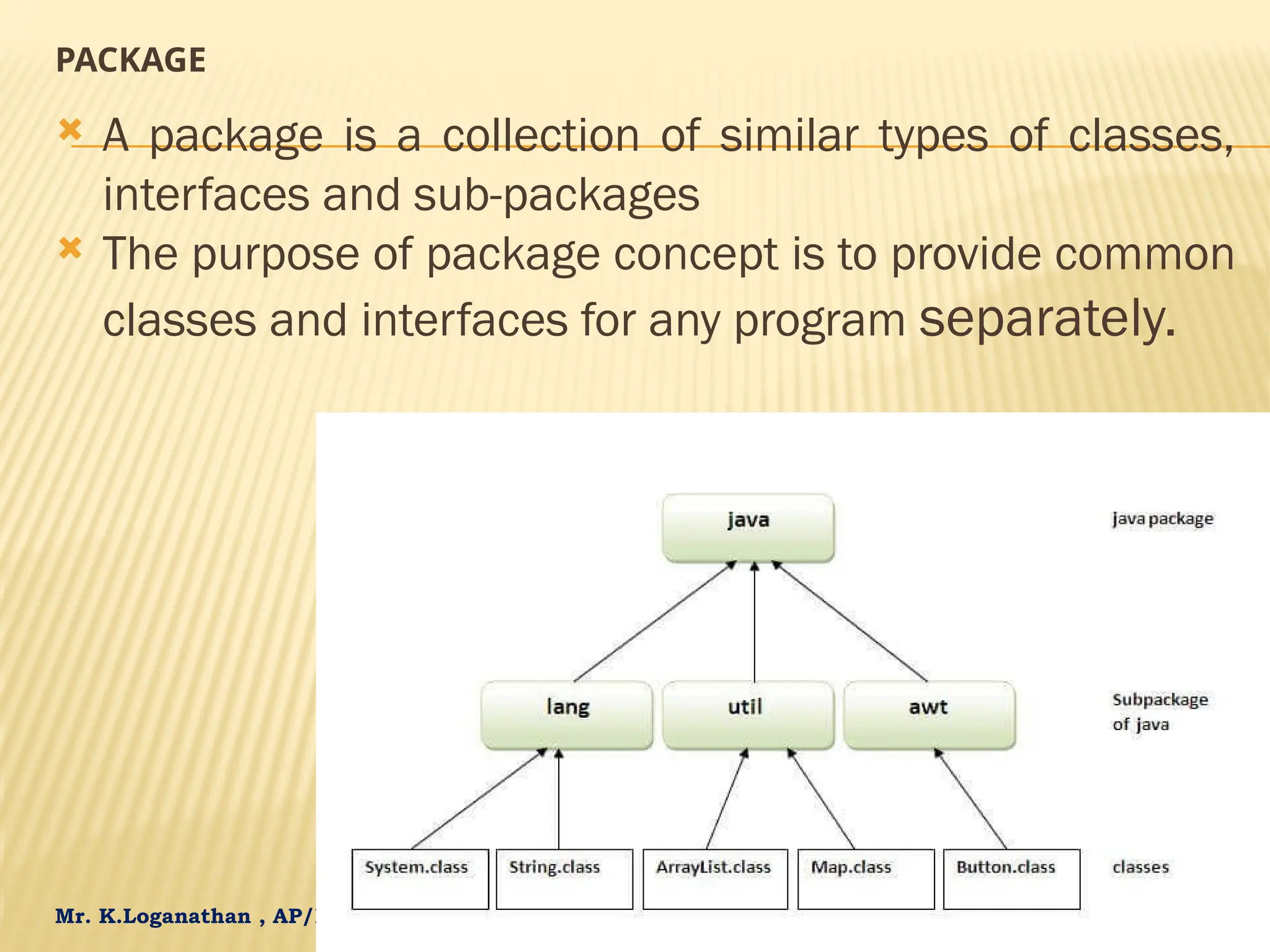
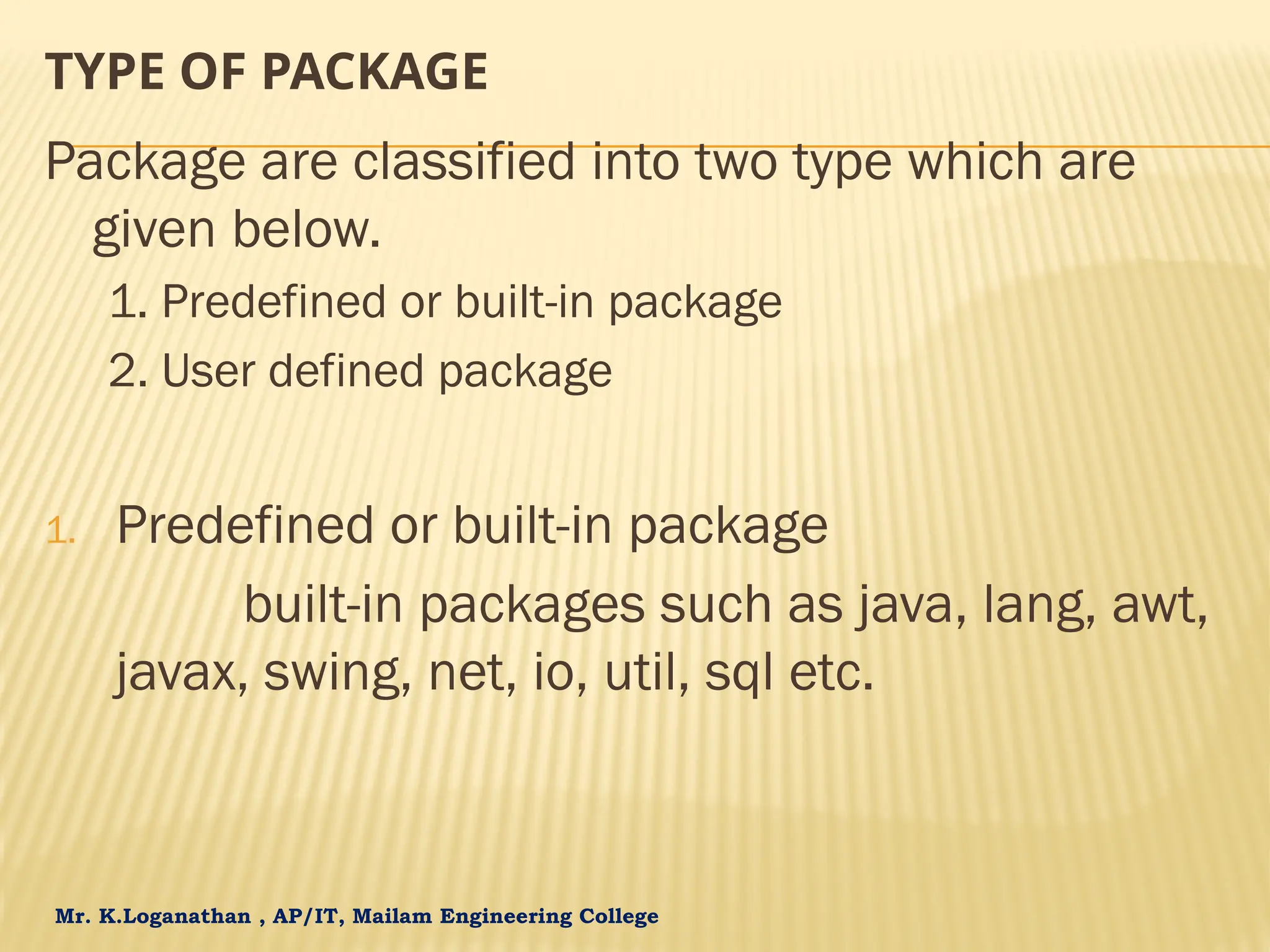


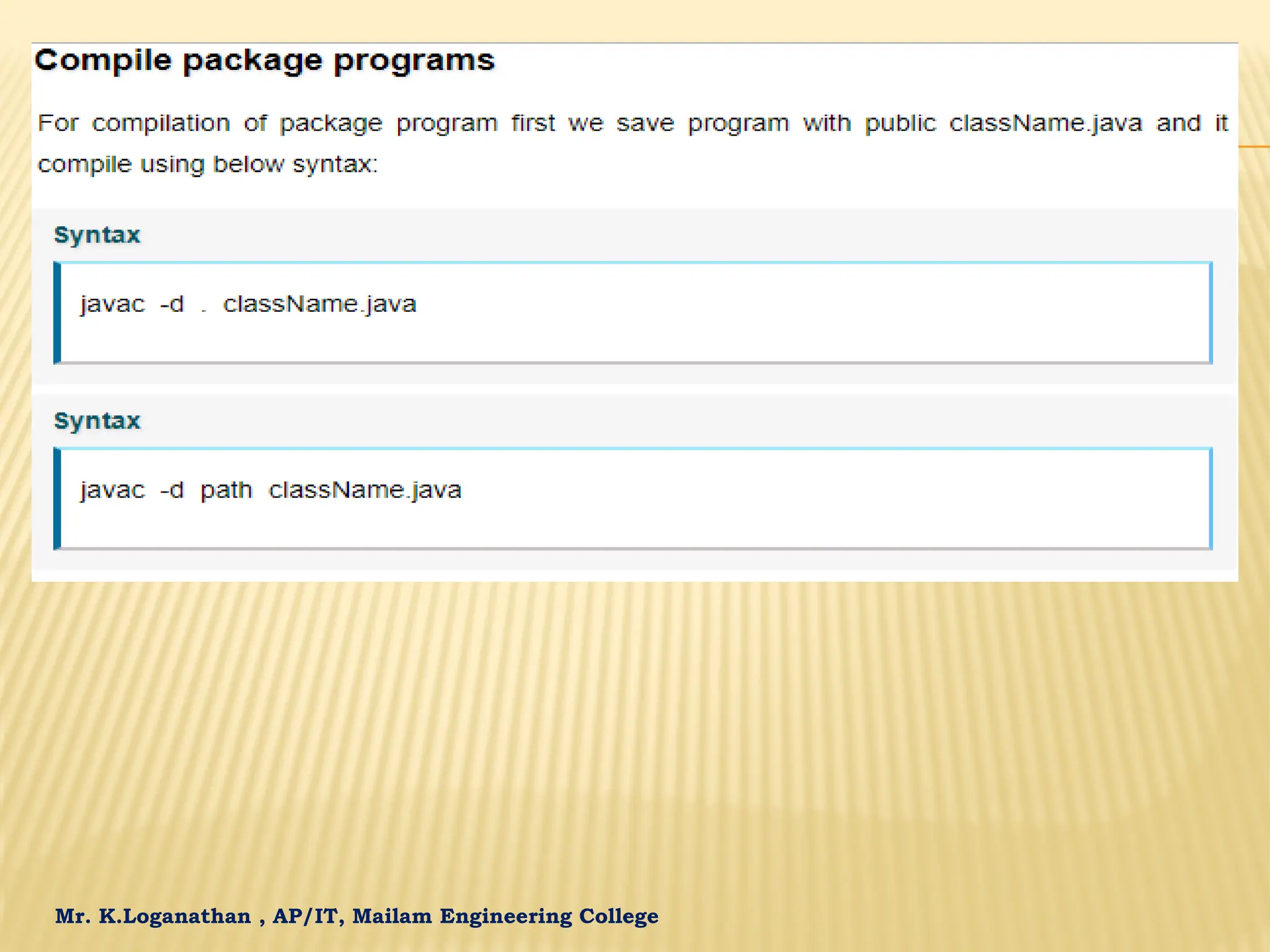
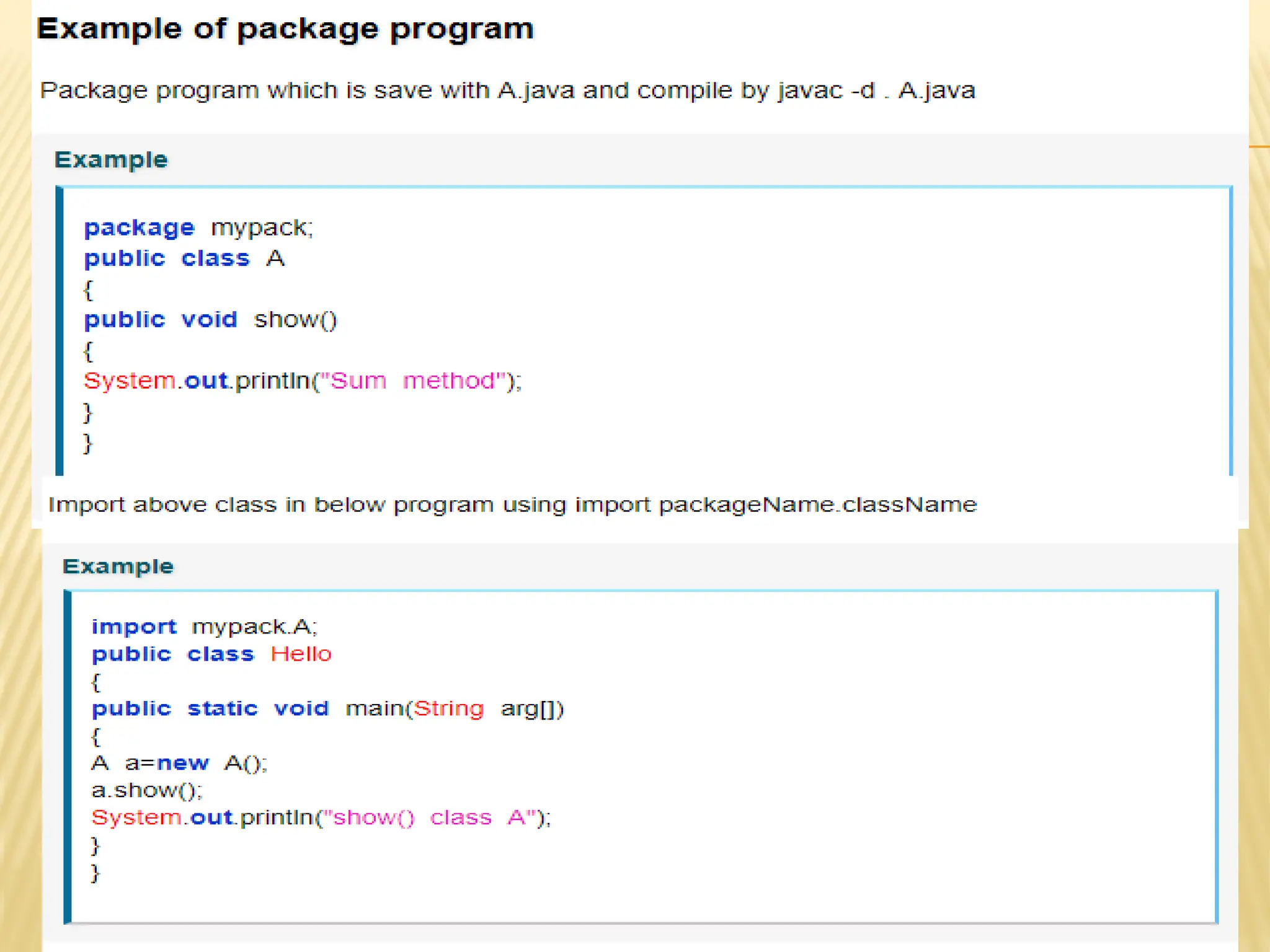
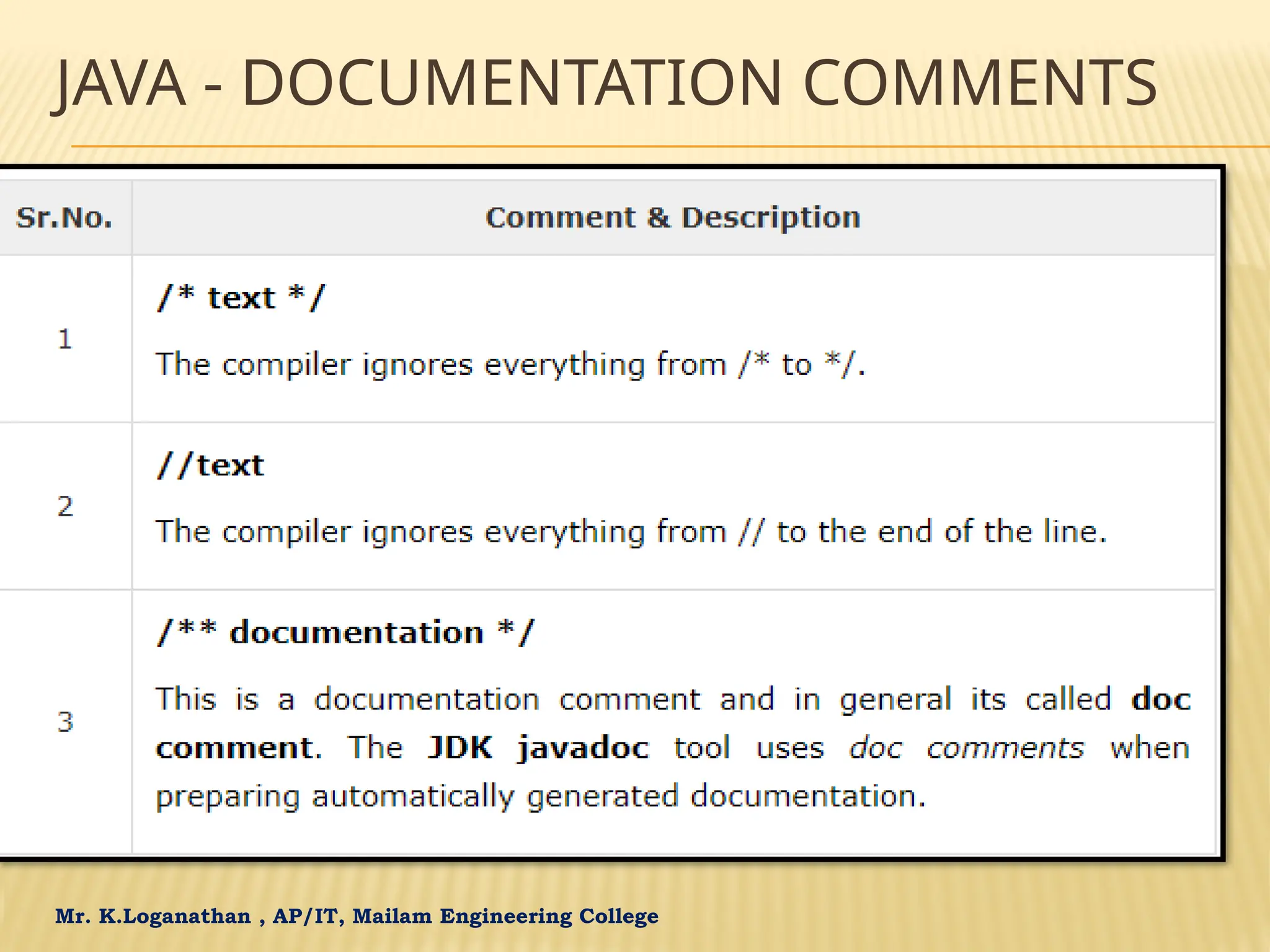
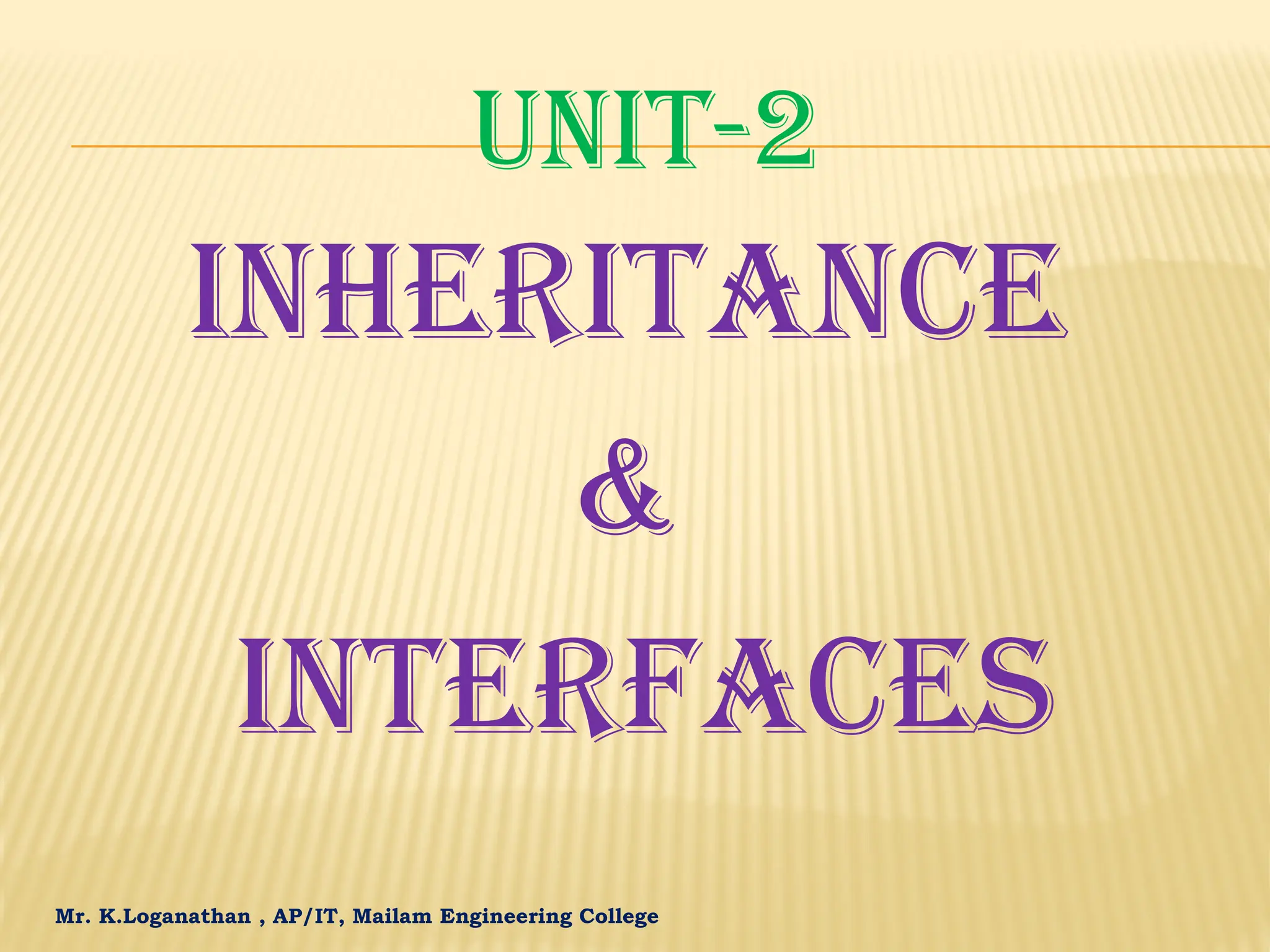
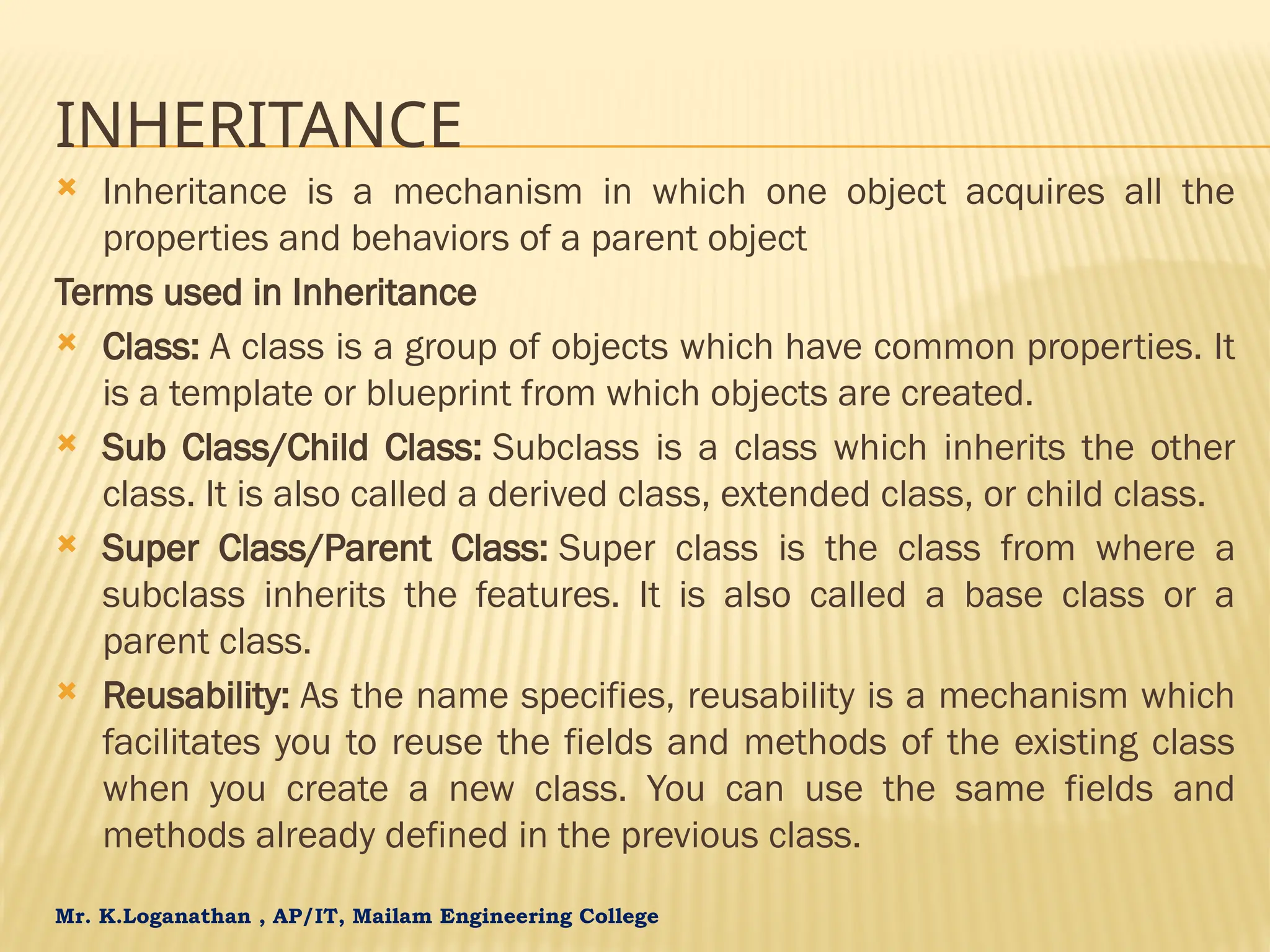

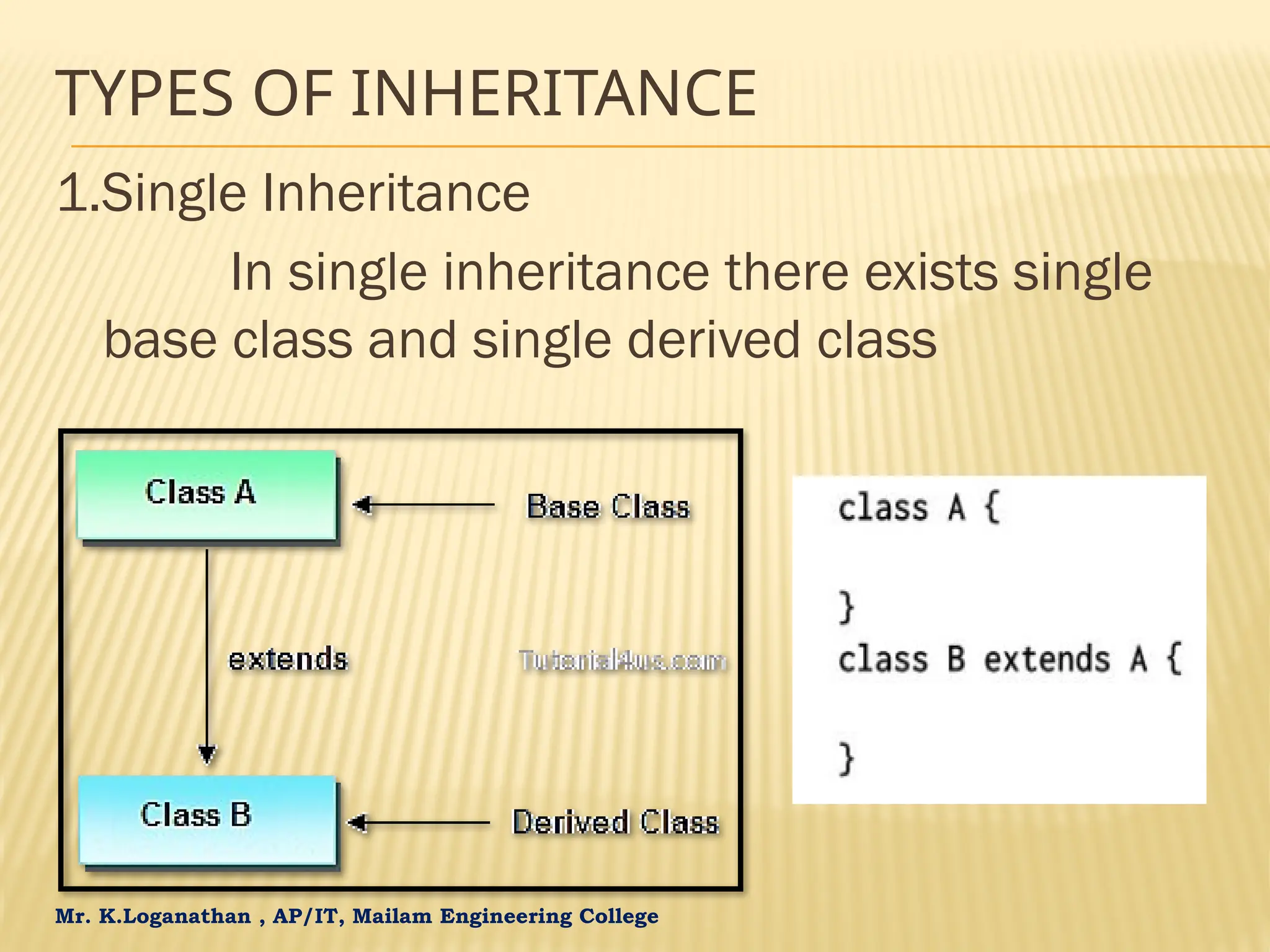
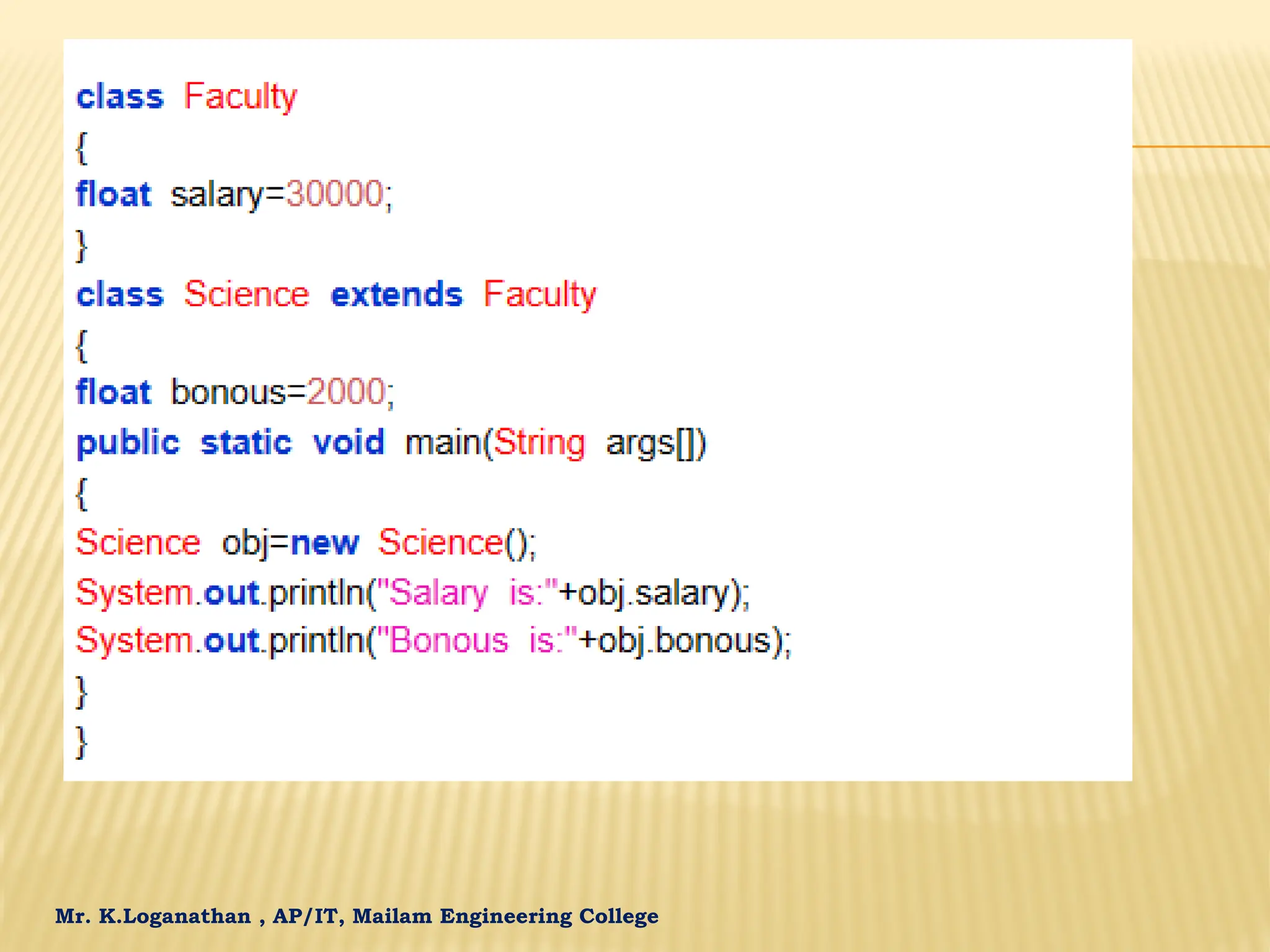




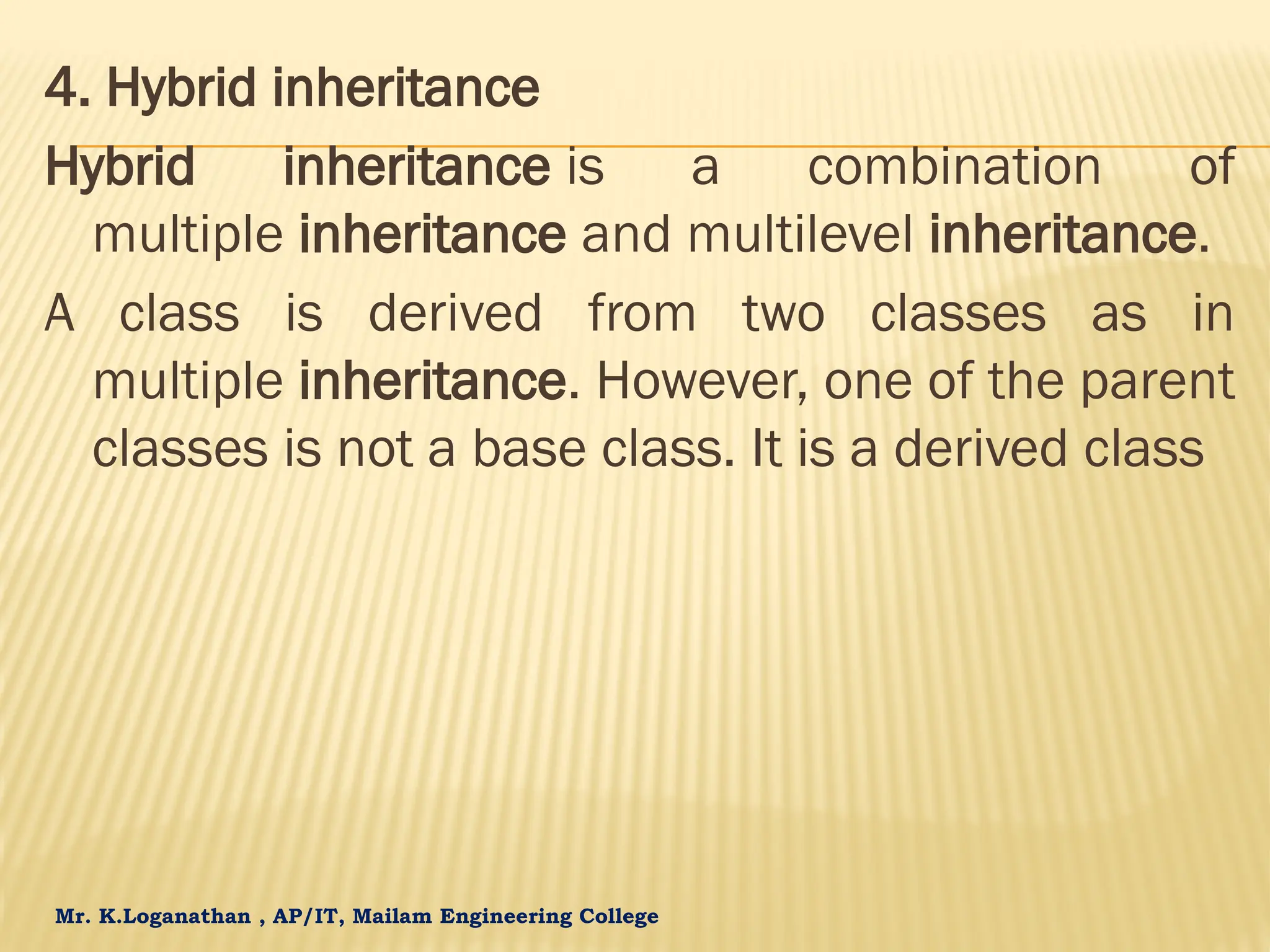


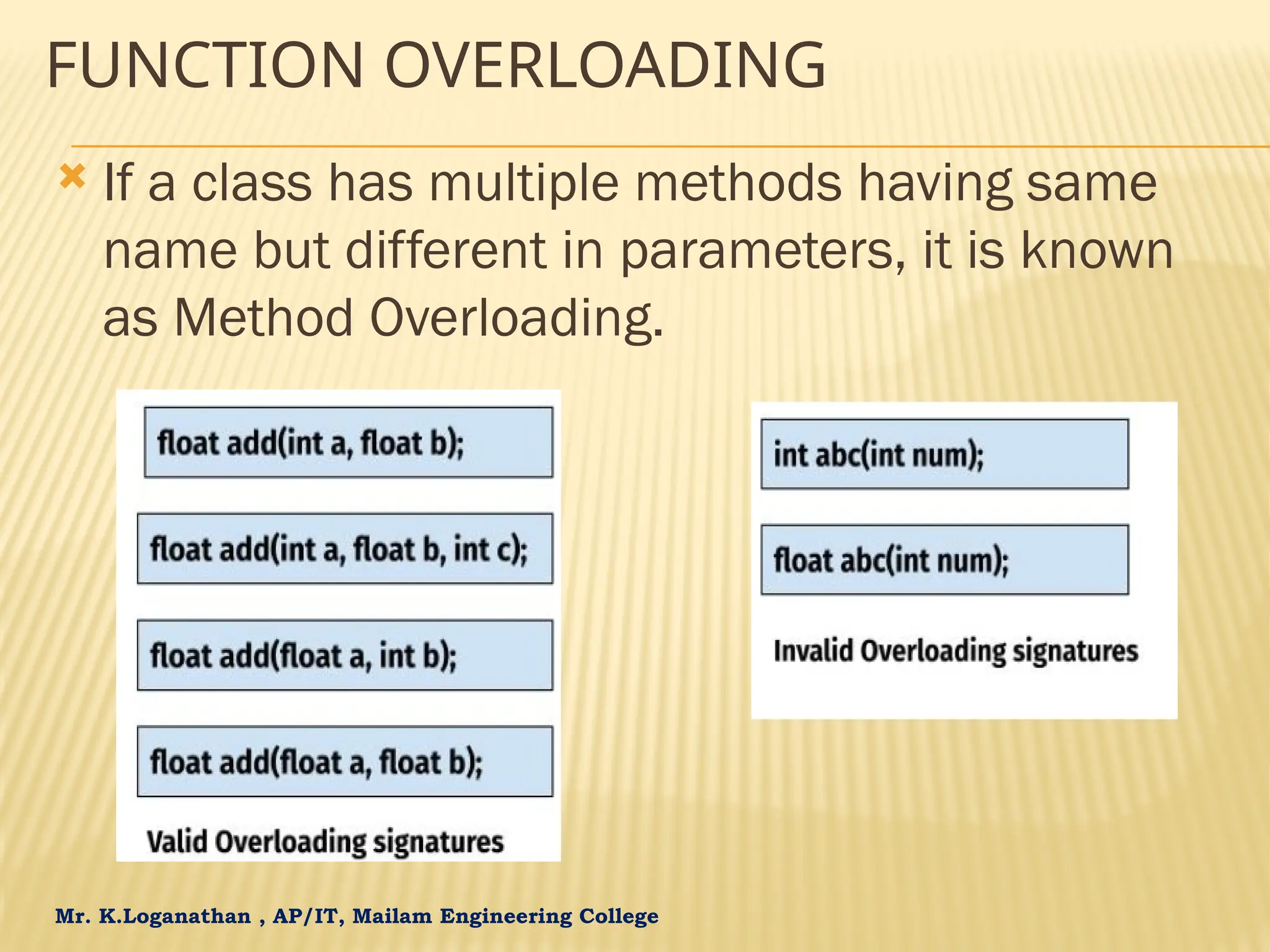
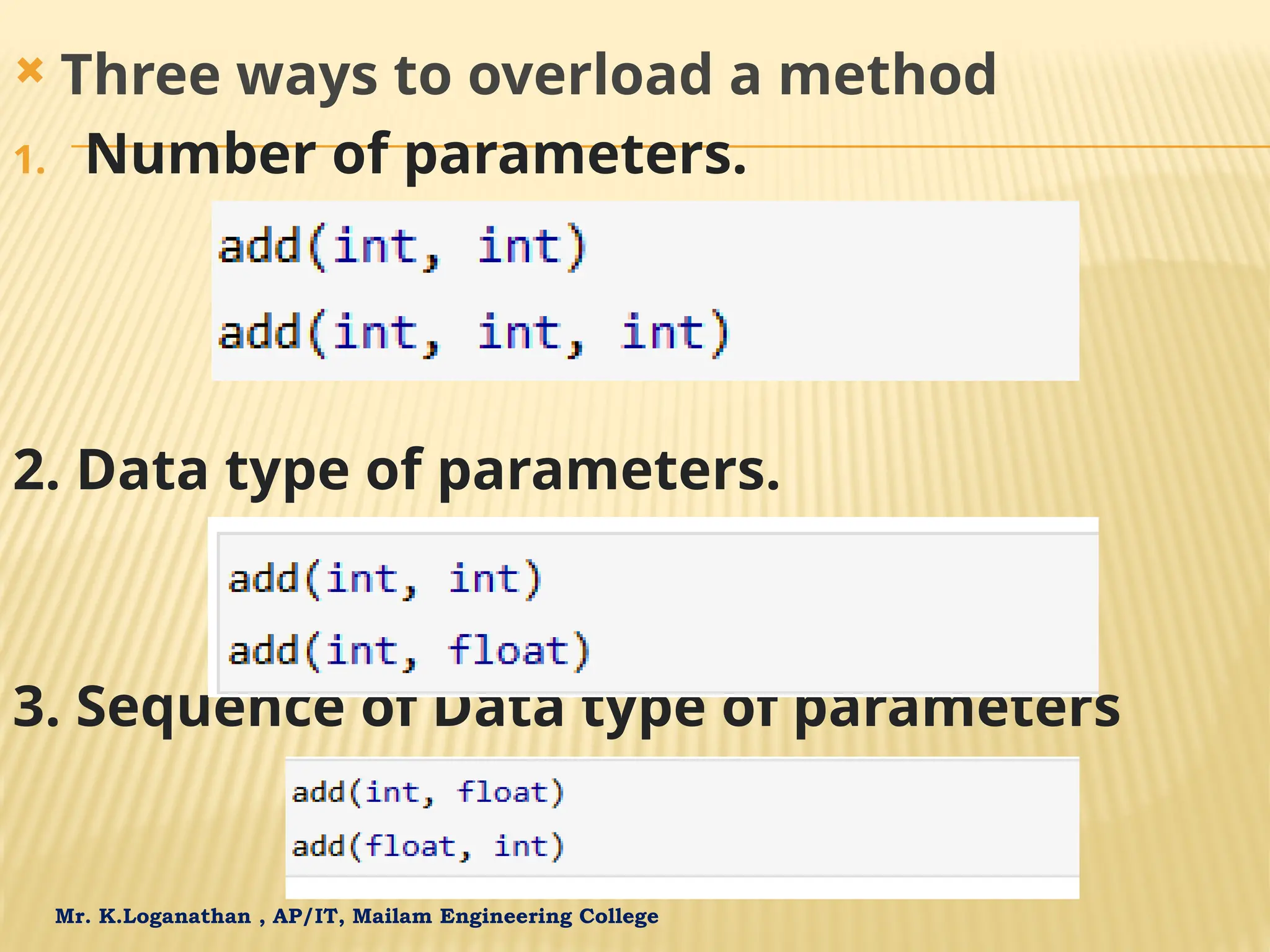
![Mr. K.Loganathan , AP/IT, Mailam Engineering College class DisplayOverloading { int add(int a, int b) { int sum = a+b; return sum; } int add(int a, int b, int c) { int sum = a+b+c; return sum; } } class JavaExample { public static void main(String args[]) { DisplayOverloading obj = new DisplayOverloading(); System.out.println(obj.add(10, 20)); System.out.println(obj.add(10, 20,30)); } }](https://image.slidesharecdn.com/oopsunit-12-240820005458-4d788f30/75/CS3391-Object-Oriented-Programming-AU-Reg-2021-87-2048.jpg)


![Mr. K.Loganathan , AP/IT, Mailam Engineering College abstract class A { abstract void callme(); void callmetoo() { System.out.println("This is a concrete method."); } } class B extends A { void callme() { System.out.println("B's implementation of callme."); } } class AbstractDemo { public static void main(String args[]) { B b = new B(); b.callme(); b.callmetoo(); } }](https://image.slidesharecdn.com/oopsunit-12-240820005458-4d788f30/75/CS3391-Object-Oriented-Programming-AU-Reg-2021-90-2048.jpg)
![Mr. K.Loganathan , AP/IT, Mailam Engineering College abstract class Vachile { abstract void speed(); // abstract method } class Bike extends Vachile { void speed() { System.out.println("Speed limit is 40 km/hr.."); } public static void main(String args[]) { Vachile obj = new Bike(); //indirect object creation obj.speed(); } }](https://image.slidesharecdn.com/oopsunit-12-240820005458-4d788f30/75/CS3391-Object-Oriented-Programming-AU-Reg-2021-91-2048.jpg)
![Mr. K.Loganathan , AP/IT, Mailam Engineering College CONSTRUCTOR IN ABSTRACT CLASS abstract class abst { abst() { System.out.println("I am in Constructor"); } abstract void run(); void display() { System.out.println("I am in display function"); } } class sample extends abst { void run() { System.out.println("I am in Abstract method"); } } class TestAbstract { public static void main(String args[]) { abst obj = new sample(); obj.run(); obj.display(); } } OutPut: I am in Constructor I am in Abstract method I am in display function](https://image.slidesharecdn.com/oopsunit-12-240820005458-4d788f30/75/CS3391-Object-Oriented-Programming-AU-Reg-2021-92-2048.jpg)
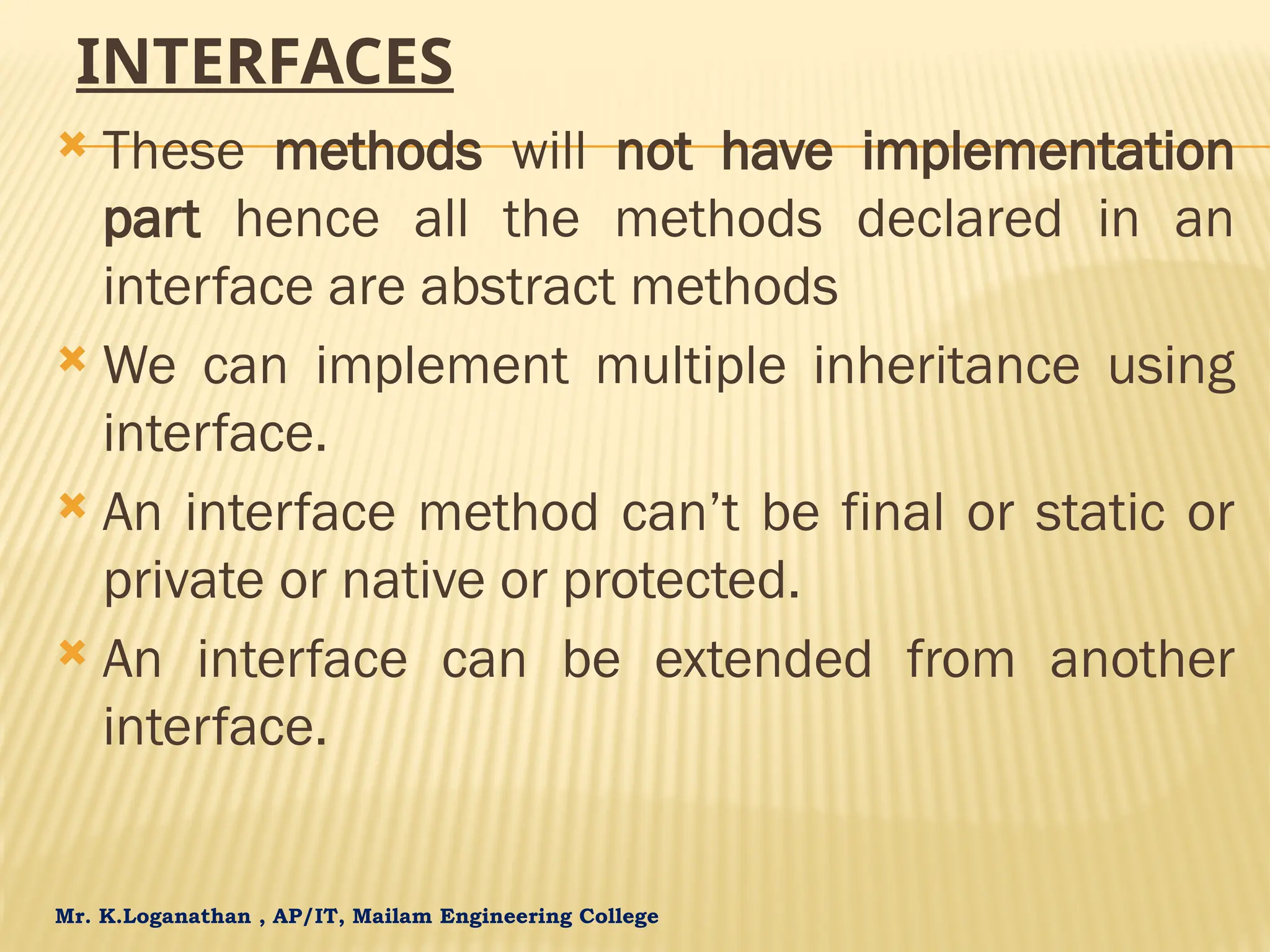
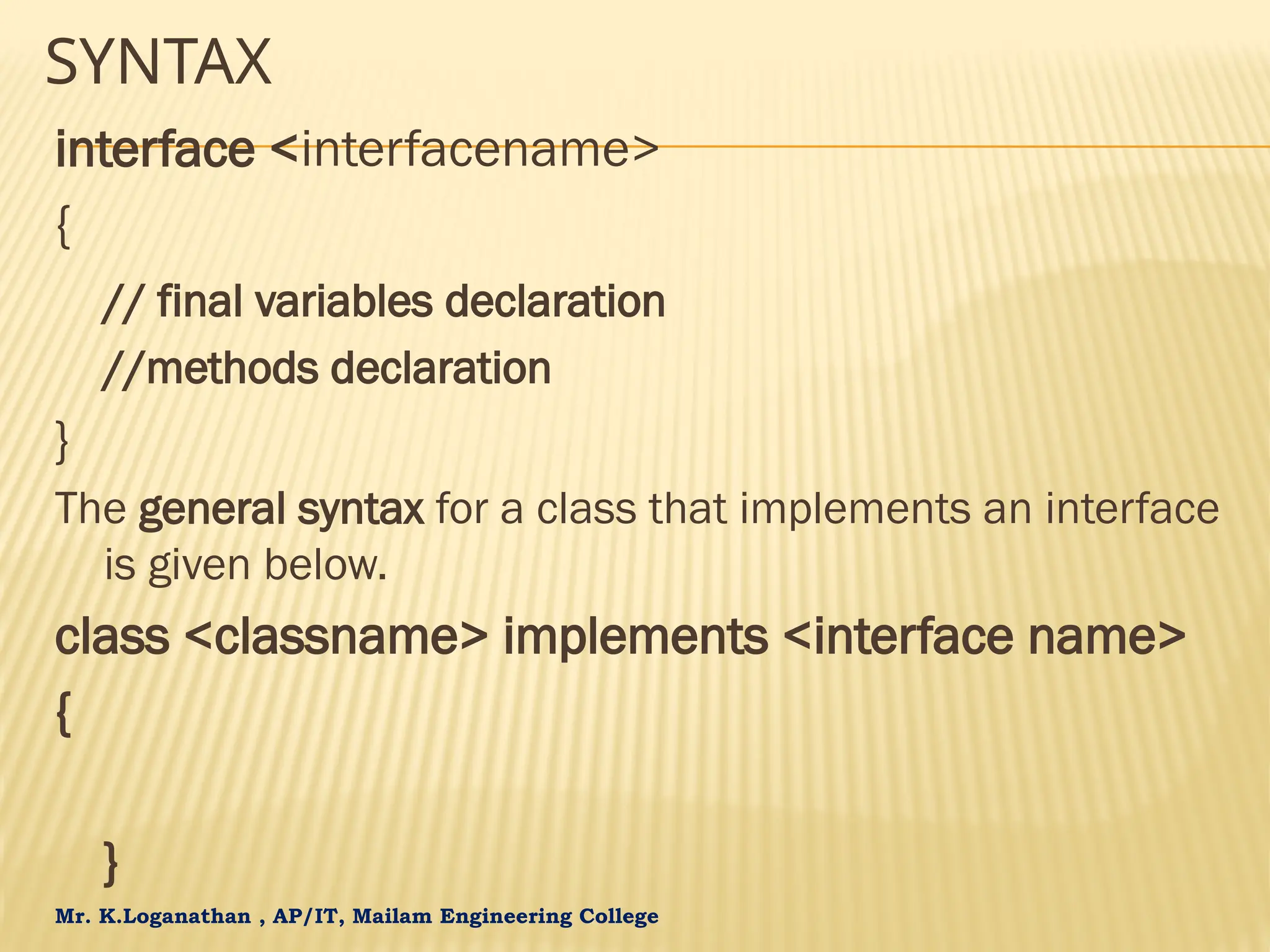
![Mr. K.Loganathan , AP/IT, Mailam Engineering College interface Area // Interface defined { final static float pi =3.14F; float compute (float x, float y); } class Rectangle implements Area { public float compute(float x, float y) { return (x*y); } } class Circle implements Area { public float compute (float x, float y) { return (pi*x*x); } } class InterfaceTest { public static void main(String args[]) { Rectangle rect = new Rectangle(); Circle cir =new Circle(); System.out.println("Area of Rectangle+rect.compute(10,20); System.out.println("Area of Circle “+ cir.compute(10,0); } }](https://image.slidesharecdn.com/oopsunit-12-240820005458-4d788f30/75/CS3391-Object-Oriented-Programming-AU-Reg-2021-95-2048.jpg)
![Mr. K.Loganathan , AP/IT, Mailam Engineering College interface Developer { void disp(); } interface Manager { void show(); } class Employee implements Developer, Manager { public void disp() { System.out.println("Hello Good Morning"); } public void show() { System.out.println("How are you ?"); } public static void main(String args[]) { Employee obj=new Employee(); obj.disp(); obj.show(); } }](https://image.slidesharecdn.com/oopsunit-12-240820005458-4d788f30/75/CS3391-Object-Oriented-Programming-AU-Reg-2021-96-2048.jpg)
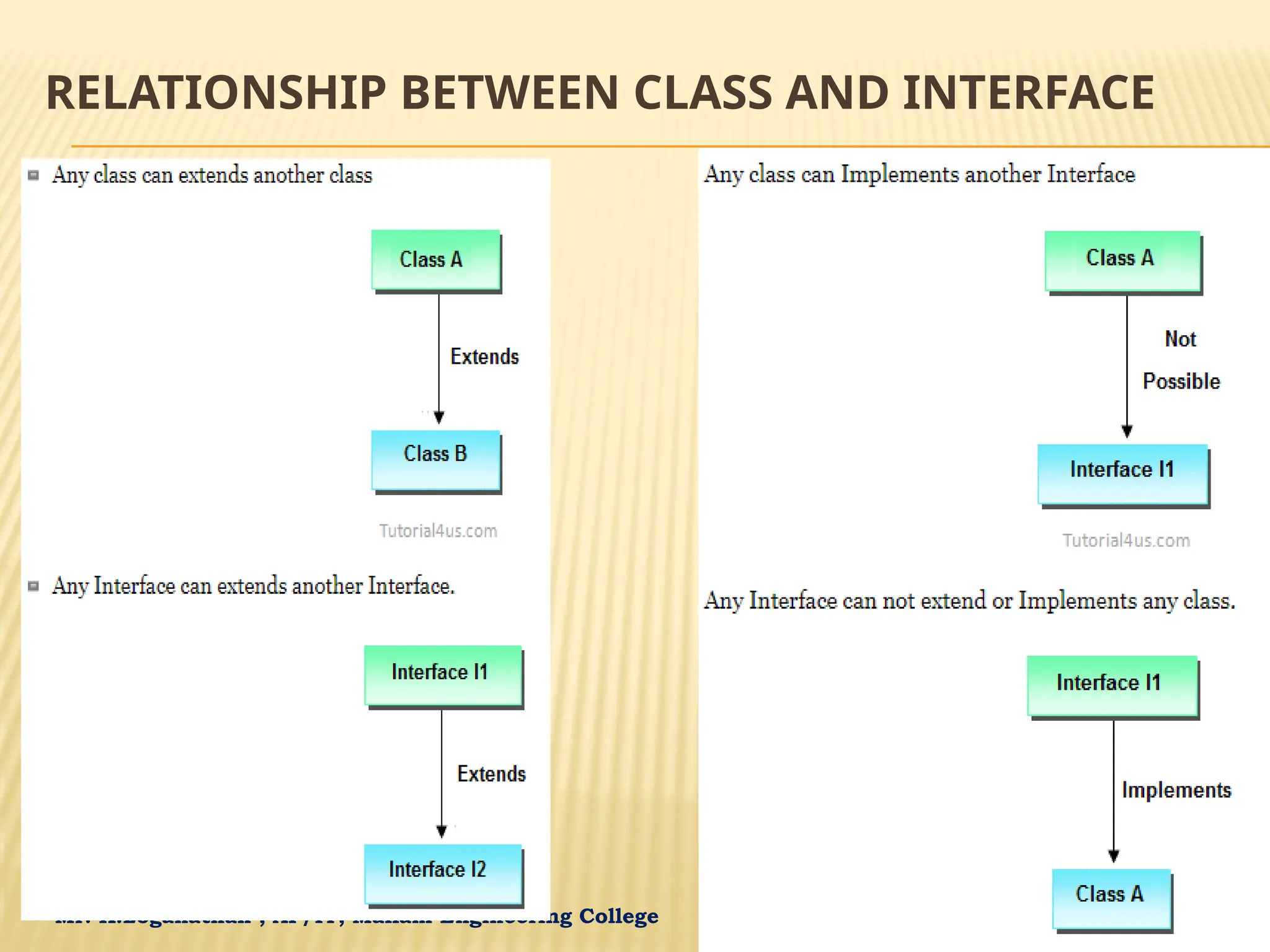
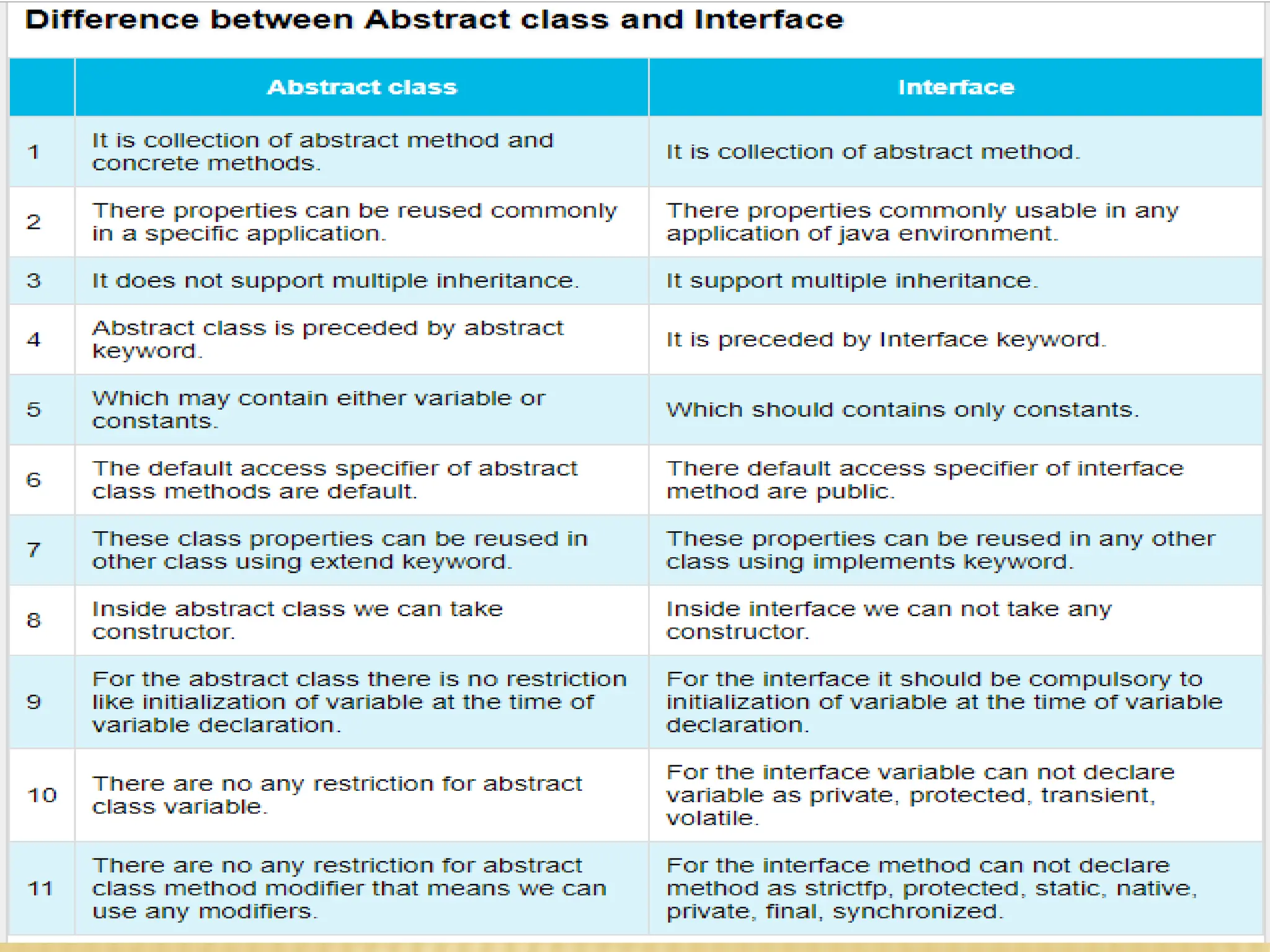
![Mr. K.Loganathan , AP/IT, Mailam Engineering College FINAL CLASS //example of abstract class that have method body final class Employee { final int salary=10000; } class Developer { void show() { System.out.println("Hello Good Morning"); } } class TestAbstraction2 { public static void main(String args[]) { //Developer obj=new Developer(); Employee o=new Employee(); //o.salary=100; System.out.println(o.salary); //Developer obj=new Developer(); //obj.show();](https://image.slidesharecdn.com/oopsunit-12-240820005458-4d788f30/75/CS3391-Object-Oriented-Programming-AU-Reg-2021-99-2048.jpg)
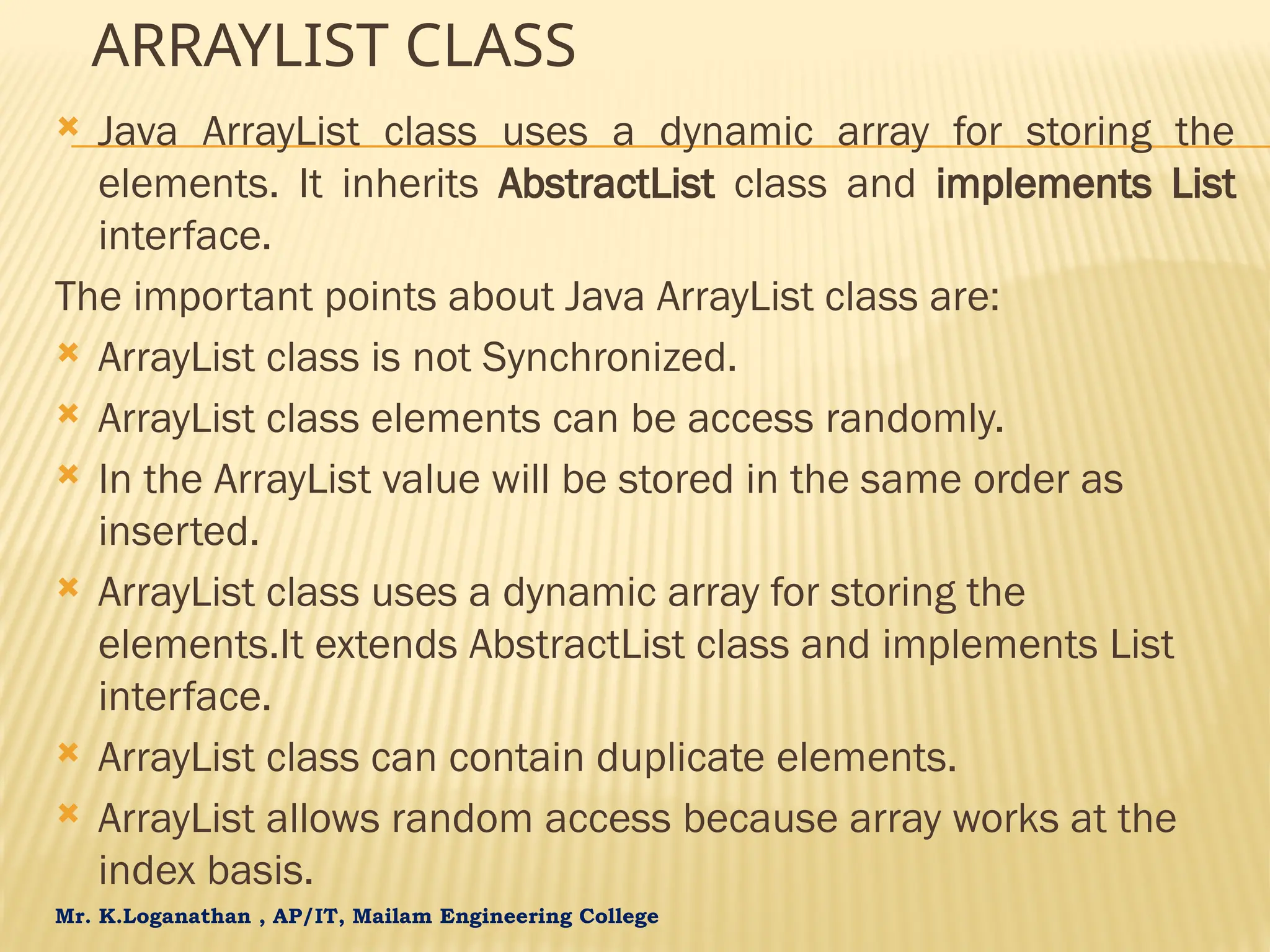
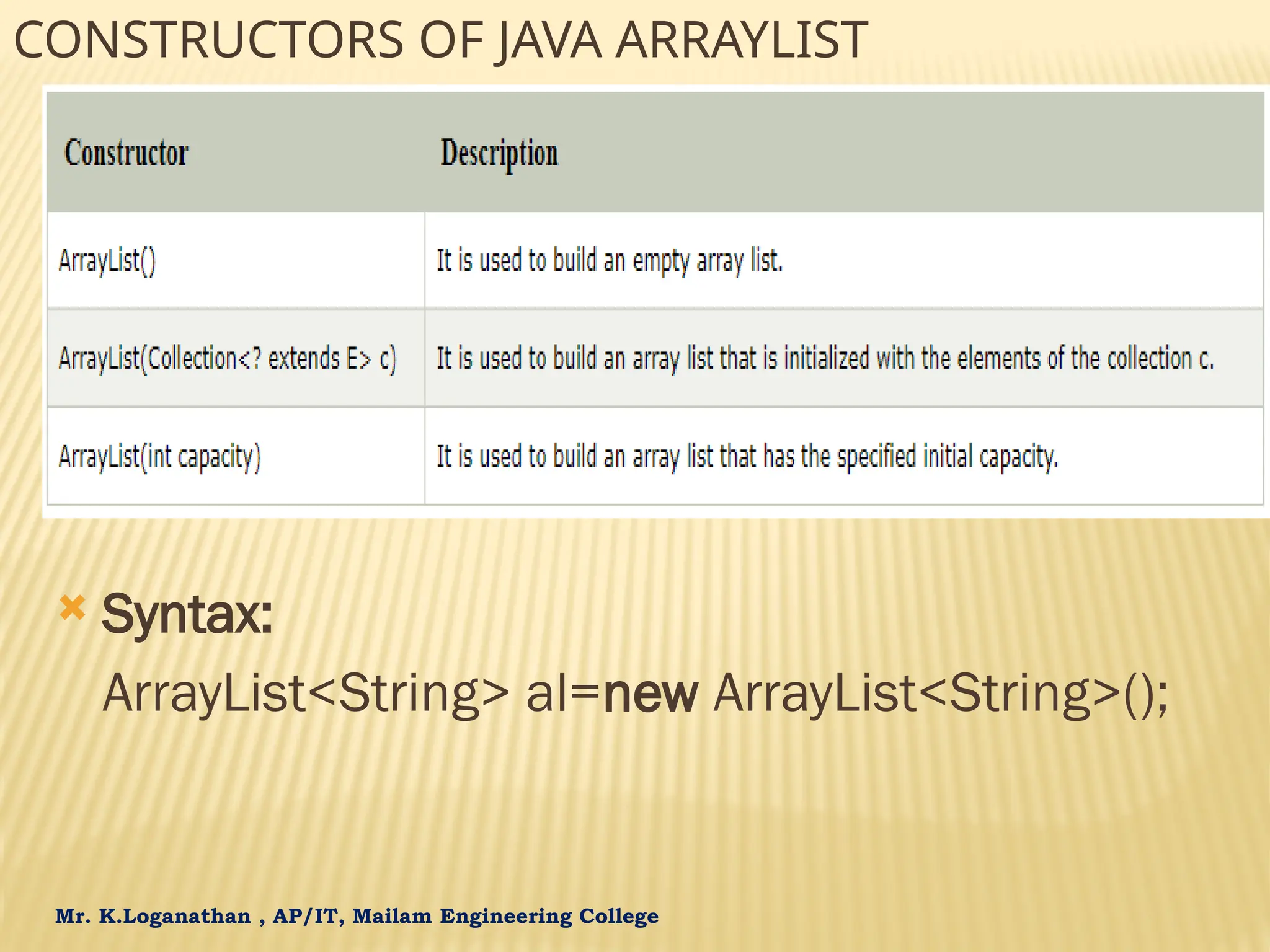
![Mr. K.Loganathan , AP/IT, Mailam Engineering College WAYS TO ITERATE THE ELEMENTS OF THE COLLECTION IN JAVA class arrayli { public static void main(String[] args) throws IOException { int n = 5; // size of ArrayList ArrayList<Integer> arrli = new ArrayList<Integer>(n); for (int i=1; i<=n; i++) arrli.add(i); System.out.println(arrli); arrli.remove(3); System.out.println(arrli); for (int i=0; i<arrli.size(); i++) System.out.print(arrli.get(i)+" "); } }](https://image.slidesharecdn.com/oopsunit-12-240820005458-4d788f30/75/CS3391-Object-Oriented-Programming-AU-Reg-2021-102-2048.jpg)

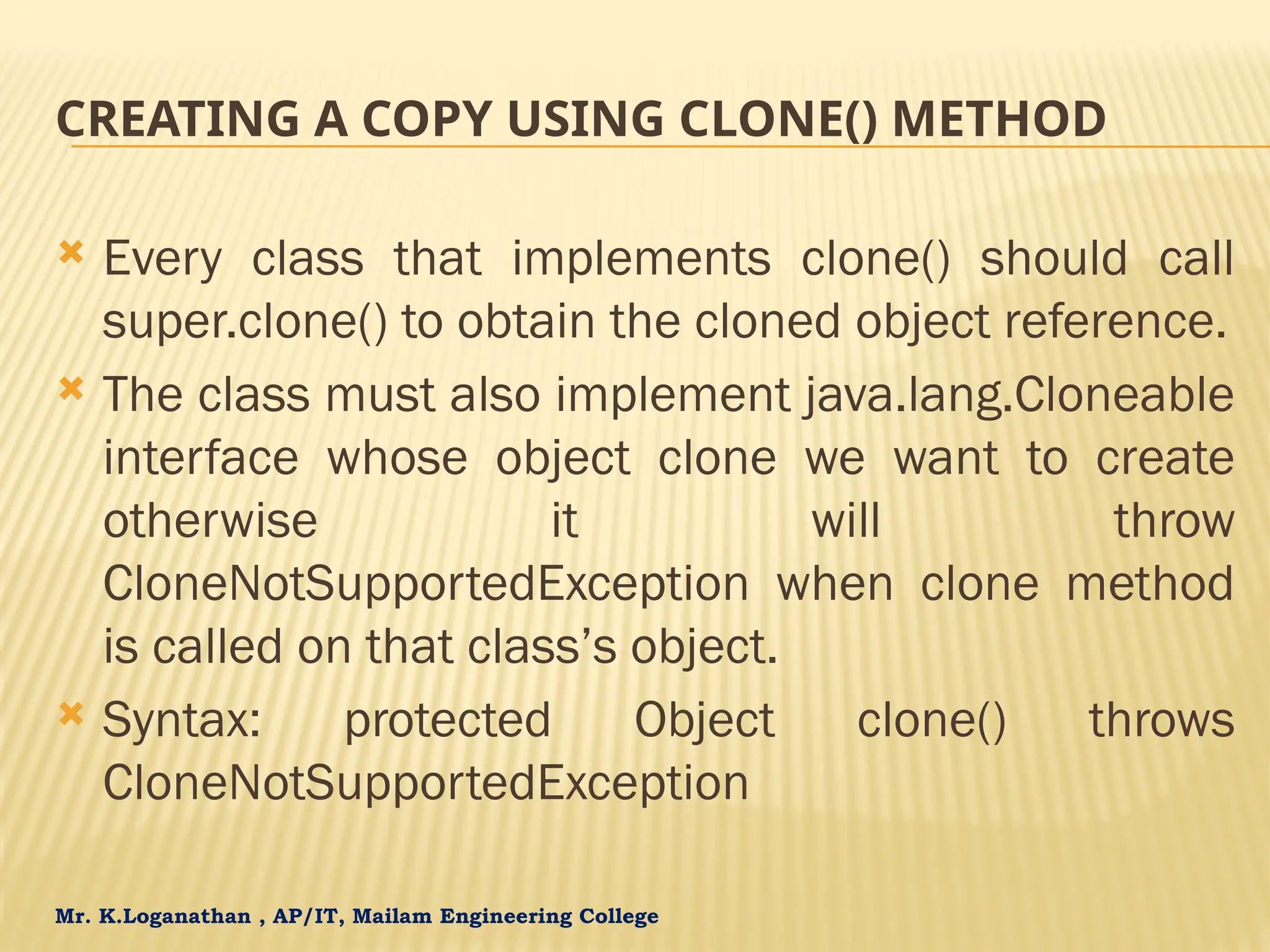
![Mr. K.Loganathan , AP/IT, Mailam Engineering College import java.util.ArrayList; class Test { int x, y; } class Test2 implements Cloneable { int a; int b; Test c = new Test(); public Object clone() throws CloneNotSupportedException { return super.clone(); } } public class Main { public static void main(String args[]) throws CloneNotSupportedException { Test2 t1 = new Test2(); t1.a = 10; t1.b = 20; t1.c.x = 30; Test2 t2 = (Test2)t1.clone(); t2.a = 100; t2.c.x = 300; t1(shallow copy) System.out.println(t1.a + " " + t1.b + " " + t1.c.x + " " + t1.c.y); System.out.println(t2.a + " " + t2.b + " " + t2.c.x + " " + t2.c.y); } }](https://image.slidesharecdn.com/oopsunit-12-240820005458-4d788f30/75/CS3391-Object-Oriented-Programming-AU-Reg-2021-105-2048.jpg)
![Mr. K.Loganathan , AP/IT, Mailam Engineering College class Student18 implements Cloneable { int rollno; String name; Student18(int rollno,String name) { this.rollno=rollno; this.name=name; } public Object clone()throws CloneNotSupportedException { return super.clone(); } public static void main(String args[]) { try { Student18 s1=new Student18(101,"amit"); Student18 s2=(Student18)s1.clone(); System.out.println(s1.rollno+" "+s1.name); System.out.println(s2.rollno+" "+s2.name); }catch(CloneNotSupportedException c){} } }](https://image.slidesharecdn.com/oopsunit-12-240820005458-4d788f30/75/CS3391-Object-Oriented-Programming-AU-Reg-2021-106-2048.jpg)
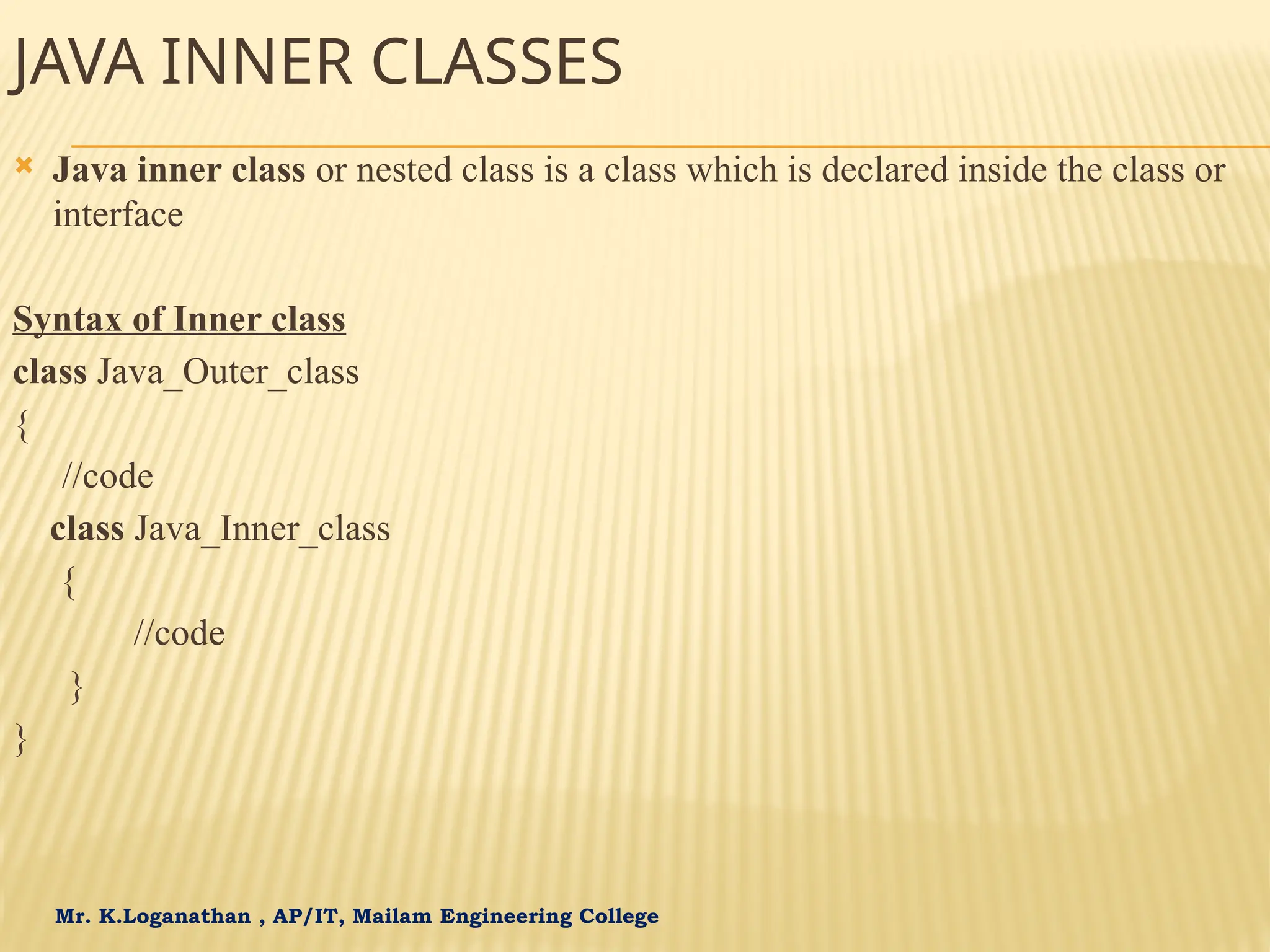
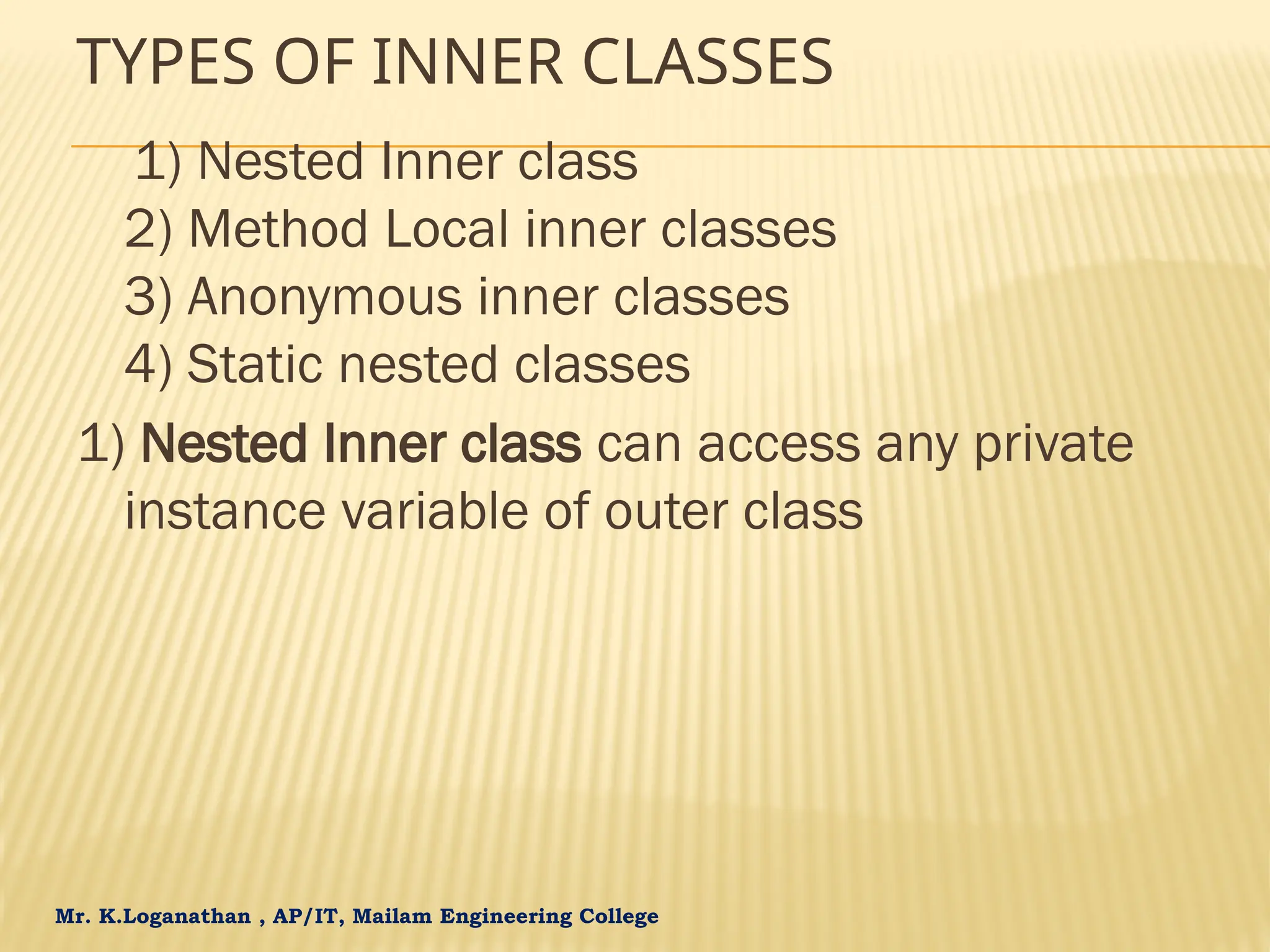
![Mr. K.Loganathan , AP/IT, Mailam Engineering College class Outer { // Simple nested inner class class Inner { public void show() { System.out.println("In a nested class method"); } } } class Main { public static void main(String[] args) { Outer.Inner in = new Outer().new Inner();](https://image.slidesharecdn.com/oopsunit-12-240820005458-4d788f30/75/CS3391-Object-Oriented-Programming-AU-Reg-2021-109-2048.jpg)
![Mr. K.Loganathan , AP/IT, Mailam Engineering College 2) METHOD LOCAL INNER CLASSES Inner class can be declared within a method of an outer class class Outer { void outerMethod() { int x = 98; System.out.println("inside outerMethod"); class Inner { void innerMethod() { System.out.println("x= "+x); } } Inner y = new Inner(); y.innerMethod(); } } class MethodLocalVariableDemo { public static void main(String[] args) { Outer x=new Outer(); x.outerMethod(); } }](https://image.slidesharecdn.com/oopsunit-12-240820005458-4d788f30/75/CS3391-Object-Oriented-Programming-AU-Reg-2021-110-2048.jpg)
![Mr. K.Loganathan , AP/IT, Mailam Engineering College 3. STATIC NESTED CLASSES Static nested classes are not technically an inner class. class Outer { private static void outerMethod() { System.out.println("inside outerMethod"); } // A static inner class static class Inner { public static void main(String[] args) { System.out.println("inside inner class Method"); outerMethod(); } } }](https://image.slidesharecdn.com/oopsunit-12-240820005458-4d788f30/75/CS3391-Object-Oriented-Programming-AU-Reg-2021-111-2048.jpg)
![Mr. K.Loganathan , AP/IT, Mailam Engineering College 4. ANONYMOUS INNER CLASSES Anonymous inner classes are declared without any name at all class Demo { void show() { System.out.println("i am in show method of super class"); } } class Flavor1Demo { // An anonymous class with Demo as base class static Demo d = new Demo() { void show() { super.show(); System.out.println("i am in Flavor1Demo class"); } }; public static void main(String[] args){ d.show(); } }](https://image.slidesharecdn.com/oopsunit-12-240820005458-4d788f30/75/CS3391-Object-Oriented-Programming-AU-Reg-2021-112-2048.jpg)